Lokpal of India
- 31 Oct 2025
In News:
The Lokpal of India, established under the Lokpal and Lokayuktas Act, 2013, was envisaged as an independent anti-corruption ombudsman capable of investigating complaints against high public officials, including the Prime Minister, Union Ministers, MPs and government officials.
Conceived in the backdrop of the 2011 anti-corruption movement, the institution began functioning meaningfully only in 2019, when the first Lokpal was constituted—marking a long-awaited step in strengthening mechanisms for integrity and transparency in governance.
Mandate and Powers
- The Lokpal is empowered to conduct inquiries and investigations under the Prevention of Corruption Act, 1988.
- Its jurisdiction extends to all public servants—Groups A to D—besides heads of government-funded institutions.
- It possesses quasi-judicial powers, including summoning witnesses, demanding documents, ordering asset freezes, and recommending prosecution.
- Crucially, it maintains supervisory authority over the CBI in cases referred by it, reinforcing independent and credible investigations.
- The Lokpal’s composition includes a Chairperson and up to eight members—half of them judicial. As of 2025, Justice A.M. Khanwilkar (retd.) serves as Chairperson, supported by a seven-member team. Members are appointed by the President upon the recommendation of a selection committee comprising the Prime Minister, Speaker of Lok Sabha, Leader of Opposition, Chief Justice of India, and an eminent jurist.
Performance Crisis and Data Trends
Despite its powerful mandate, the Lokpal’s performance has raised serious concerns. Since inception, it has received 6,955 complaints, yet only 289 preliminary inquiries have been ordered. Out of these, a mere seven cases have progressed to the prosecution stage—an alarming indicator of institutional underutilisation.
The declining public engagement is sharper still. Annual complaints peaked at 2,469 in 2022–23 but plummeted to 233 in 2025, suggesting fading public confidence. Nearly 90% of all complaints were received in its first four years (2019–2023), while the past three years recorded only 691 complaints combined.
Civil society groups have criticised the procedural rigidity of the Lokpal. Activists point out that many complaints are dismissed on technical grounds such as format errors, while substantive allegations remain unaddressed. Further, the Lokpal’s failure to upload annual reports since 2021–22 has generated questions about its transparency and accountability.
Institutional Weaknesses and Controversies
A major lacuna has been the delayed operationalisation of the prosecution wing, notified only in June 2025—twelve years after the enactment of the Lokpal Act—severely constraining its ability to pursue legal action. The credibility of the institution also came under public scrutiny when it issued a tender to procure seven BMW 330Li luxury cars for its Chairperson and members. Critics argue that an anti-corruption body must demonstrate fiscal restraint and ethical prudence in its own functioning.
Way Forward
Strengthening the Lokpal requires structural, procedural, and ethical reforms. A real-time digital dashboard should be created to enable public tracking of cases and reduce opacity. Complaint formats must be simplified to ensure accessibility for ordinary citizens. Institutional autonomy must be reinforced with adequate staffing for inquiry and prosecution wings. Annual reports should be mandatorily published and tabled in Parliament. Above all, Lokpal must cultivate public trust by adopting austerity and demonstrating moral credibility.
Conclusion
The Lokpal was created to be the custodian of public integrity—an independent safeguard against high-level corruption. However, its diminishing complaint inflow, administrative inertia, and controversies signal a crisis of legitimacy. Revitalising the institution through stronger transparency, greater accountability, and ethical restraint is essential if it is to fulfil its constitutional promise of clean and accountable governance.
Blockchain and the National Blockchain Framework (NBF)
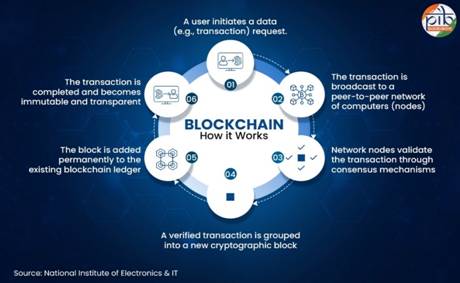
- 30 Oct 2025
In News:
Blockchain technology, once associated primarily with cryptocurrencies, has emerged as a transformative tool for establishing digital trust, enhancing transparency, and reducing systemic inefficiencies in governance. India, aiming to modernise its public service delivery architecture, has adopted a strategic approach through the National Blockchain Framework (NBF), launched in September 2024 with a budget of ?64.76 crore.
Understanding Blockchain Technology and Its Governance Utility
- Blockchain is a distributed, immutable and cryptographically secure ledger of transactions maintained across multiple nodes. Its inherent strengths—tamper resistance, decentralisation, and transparency—make it an ideal backbone for public data systems.
- India’s governance needs are best served by permissioned private blockchains, where authorised entities validate transactions while ensuring confidentiality. Other blockchain variants—public, consortium, and hybrid models—offer differing levels of access and decentralisation but are less suited for sensitive government datasets.
Core Architecture of the National Blockchain Framework
1. Vishvasya Blockchain Stack
At the heart of the NBF is the Vishvasya Blockchain Stack, an indigenous and modular platform offering:
- Blockchain-as-a-Service (BaaS) to enable rapid deployment of blockchain applications without the need for independent infrastructure.
- Distributed infrastructure across NIC data centres in Bhubaneswar, Pune, and Hyderabad for resilience and fault tolerance.
- Permissioned blockchain layer, ensuring participation only by verified entities.
- Open APIs and integration services that simplify connectivity with existing e-governance platforms.
2. NBFLite – Sandbox for Innovation
- NBFLite provides startups, researchers, and academic institutions with a controlled environment to prototype blockchain solutions using pre-configured smart contract templates for supply chains, certificates, and governance use cases.
3. Praamaanik – Mobile App Verification
- Praamaanik uses blockchain to verify the authenticity of mobile applications, protecting users from counterfeit apps and fraudulent customer support platforms.
4. National Blockchain Portal
- This serves as the unified gateway for guidelines, standards, and adoption roadmaps, promoting interoperability across sectors.
Blockchain-Enabled Chains Transforming Public Service Delivery
- Certificate and Document Chain: Government agencies use blockchain for secure issuance, storage, and verification of documents such as academic records, ration cards, driving licences, and birth/death certificates.Over 34 crore documents have been verified using this system.
- Logistics Chain: Used for tracking goods across supply stakeholders.Example: Karnataka’s Aushada system tracks medicines from manufacturers to hospitals, ensuring authenticity, preventing spurious drugs, and improving traceability.
- Property Chain: Immutable records of property transactions help reduce land disputes, establish ownership clarity, and expedite land transfers.
- Judiciary Chain and ICJS: Blockchain supports electronic delivery of summons, bail orders, and judicial notices.The Inter-operable Criminal Justice System (ICJS) integrates evidence, case files, and judicial documents across agencies for seamless coordination.
Sectoral Adoption by National Regulators
- TRAI employs Distributed Ledger Technology to monitor SMS transmission, reducing spam and enhancing regulatory compliance for over 1.13 lakh entities.
- RBI uses blockchain for its Digital Rupee (e?) pilot, demonstrating secure, traceable digital payments.
- NSDL has adopted blockchain for Debenture Covenant Monitoring, enabling time-stamped, tamper-proof monitoring of asset cover and compliance.
Capacity Building and Skill Development
MeitY has trained 21,000+ officials on blockchain applications. Academic initiatives—PG Diploma in FinTech & Blockchain, C-DAC’s BLEND programme, and FutureSkills PRIME—are developing specialised talent for India's blockchain workforce.
Way Forward
India is testing blockchain-based solutions for land records, GST chain, blood bank management, and PDS transparency. The NBF represents a strategic shift from fragmented digital systems to a unified trust-based digital governance model, positioning India as a global leader in blockchain-enabled public services.
UNESCO Global Education Report 2025
- 29 Oct 2025
In News:
The UNESCO Global Education Report 2025 offers a critical evaluation of global progress toward gender equality in education, exposing persistent disparities despite decades of international commitments. Although substantial improvements have been recorded since the 1995 Beijing Declaration, an alarming 133 million girls worldwide remain out of school, signalling unfinished global obligations.
Progress Achieved
- The report highlights significant gains in enrolment and access. Compared to 1995, 91 million more girls are in primary school and 136 million more are enrolled in secondary education.
- Tertiary education has witnessed the most dramatic progress, with women's enrolment tripling from 41 million to 139 million. These trends reflect global investments in universal education programmes, gender inclusion policies, and financial support mechanisms.
Regional Variations
Despite overall progress, regional disparities persist. Central and South Asia have achieved gender parity in secondary education, demonstrating effective policy interventions. Conversely, Sub-Saharan Africa and Oceania continue to lag, constrained by poverty, rural isolation, armed conflicts, and socio-cultural restrictions. In countries such as Mali and Guinea, lower secondary completion rates for girls remain below 20%, indicating severe structural inequities. In contrast, Latin America and the Caribbean show higher dropout rates among boys, underscoring region-specific challenges.
Quality and Inclusivity Deficits
The report stresses that enrolment gains alone do not translate into gender equality. Only two-thirds of countries have compulsory sexuality education at the primary level, and gender biases persist in textbooks and curricula. These embedded stereotypes perpetuate discriminatory norms and restrict girls’ aspirations and subject choices. Safety concerns—including school-related gender-based violence—further hinder learning continuity, particularly for adolescent girls.
Leadership Inequality
Although women comprise a significant proportion of the global teaching workforce, their presence in leadership positions remains limited. Only 30% of higher education leadership roles are held by women, revealing systemic barriers such as limited institutional support, leadership pipelines, and entrenched patriarchal structures. This leadership gap undermines gender-sensitive decision-making within education systems.
Economic and Social Implications
UNESCO reinforces that girls’ education is not merely a human rights imperative but an economic and socio-developmental necessity. The World Bank (2024) estimates that closing the gender gap in education could boost global GDP by $15–30 trillion, reflecting the massive economic potential of women’s participation in the workforce. Educated girls contribute to improved health outcomes, reduced poverty, enhanced labour force participation, and greater intergenerational development.
Way Forward
The report calls for gender-transformative policies—including equitable curricula, strengthened pathways for women in leadership, expanded sexuality education, safer learning environments, and evidence-based monitoring. Achieving the vision of the Beijing Declaration requires political will, sustained investments, and community-level engagement to dismantle structural barriers.
Can Rural Education Transform Migration Patterns? Reimagining Opportunities Beyond Cities
- 28 Oct 2025
In News:
Migration has been a central feature of India’s socio-economic evolution, but the growing exodus of rural youth to urban centres signals deep developmental imbalances. While migration is natural in a dynamic economy, its scale—particularly among young people—highlights failures in generating dignified rural livelihoods, aligning education with market needs, and creating resilient local ecosystems.
Understanding the Scale and Nature of Youth Migration
- Magnitude: Nearly 29% of India’s population are migrants; 89% originate from rural areas.
- Age Profile: Over half of all migrants are aged 15–25, indicating the loss of India’s most productive demographic.
- Pandemic Exposure: The 2020 Covid-19 lockdown forced 40 million workers to return home, revealing the fragility of informal urban employment.
- Gender Dynamics: Men migrate mainly for work, while 86.8% of women migrate due to marriage, reflecting persistent social norms.
- Socio-economic Profile: Higher migration rates among SC, OBC, and low-income groups show distress-driven mobility.
Drivers of Youth Migration from Rural India
a. Rural Employment Deficit
- Limited non-farm jobs; 49% migrants work as daily wagers and 39% in temporary industrial roles.
- Low returns from agriculture due to fragmented landholdings and climate exposure.
b. Education–Employment Mismatch
- Rural education lacks industry-relevant skills.
- Graduate unemployment exceeds 15% (CMIE 2024), indicating inadequate employability.
c. Income and Infrastructure Gaps
- Rural incomes fail to meet basic needs.
- Weak connectivity, inadequate credit access, and poor logistics hinder local enterprise formation.
d. Urban Pull Factors
- Cities offer perceived opportunities, higher wages, and mobility.
- However, migrants face unsafe housing, exploitation, and precarious informal jobs—88% lack social security.
Impact of Migration on Rural and Urban Landscapes
a. Urban Challenges
- Overcrowding, pollution, rising pressure on housing and infrastructure.
- Growth of slums in megacities like Delhi and Mumbai.
b. Rural Depopulation
- Loss of youth weakens agricultural productivity and local governance.
- Declining rural social capital affects community cohesion.
c. Social and Psychological Effects
- Family separation leads to stress, anxiety, and economic insecurity among dependents.
- Women migrants rarely enter the workforce, deepening gender gaps.
Policy Interventions and Initiatives
- MGNREGA ensures wage support during lean seasons, reducing distress migration.
- DDU-GKY, PMKVY provide vocational training to improve employability.
- PM-Mudra, Start-Up India, SVEP encourage rural entrepreneurship.
- 10,000 FPO initiative strengthens farmer collectives and value chains.
- BharatNet, PMGSY, rural BPOs expand digital and physical connectivity.
Way Forward: Reimagining Rural Education and Ecosystems
a. Integrating Education with Local Economies
- Embed vocational, digital, and agri-tech skills into rural curricula.
- Link schools and colleges to local enterprises and industries.
b. Diversifying Rural Non-Farm Sectors
- Develop employment in handicrafts, food processing, logistics, renewable energy, and agri-tourism.
c. Building Digital Ecosystems
- Invest in 5G connectivity, e-commerce platforms, tele-work hubs, and digital service centres.
d. Encouraging Local Entrepreneurship
- Promote success stories like Raigad’s BalaramBandagale to inspire reverse migration and rural innovation.
e. Strengthening Social Protection
- Ensure universal portability of PDS, health insurance, and pensions for mobile workers.
Conclusion
India must shift from a model where migration is a compulsion to one where it becomes a choice. Strengthening rural education, diversifying local economies, and empowering youth with market-ready skills can address structural causes of migration. A balanced rural–urban development framework—anchored in employment-linked learning, digital connectivity, and entrepreneurship—will help revitalise rural India and support inclusive, sustainable growth.
India’s Renewable Energy Transition: From Expansion to System Strength
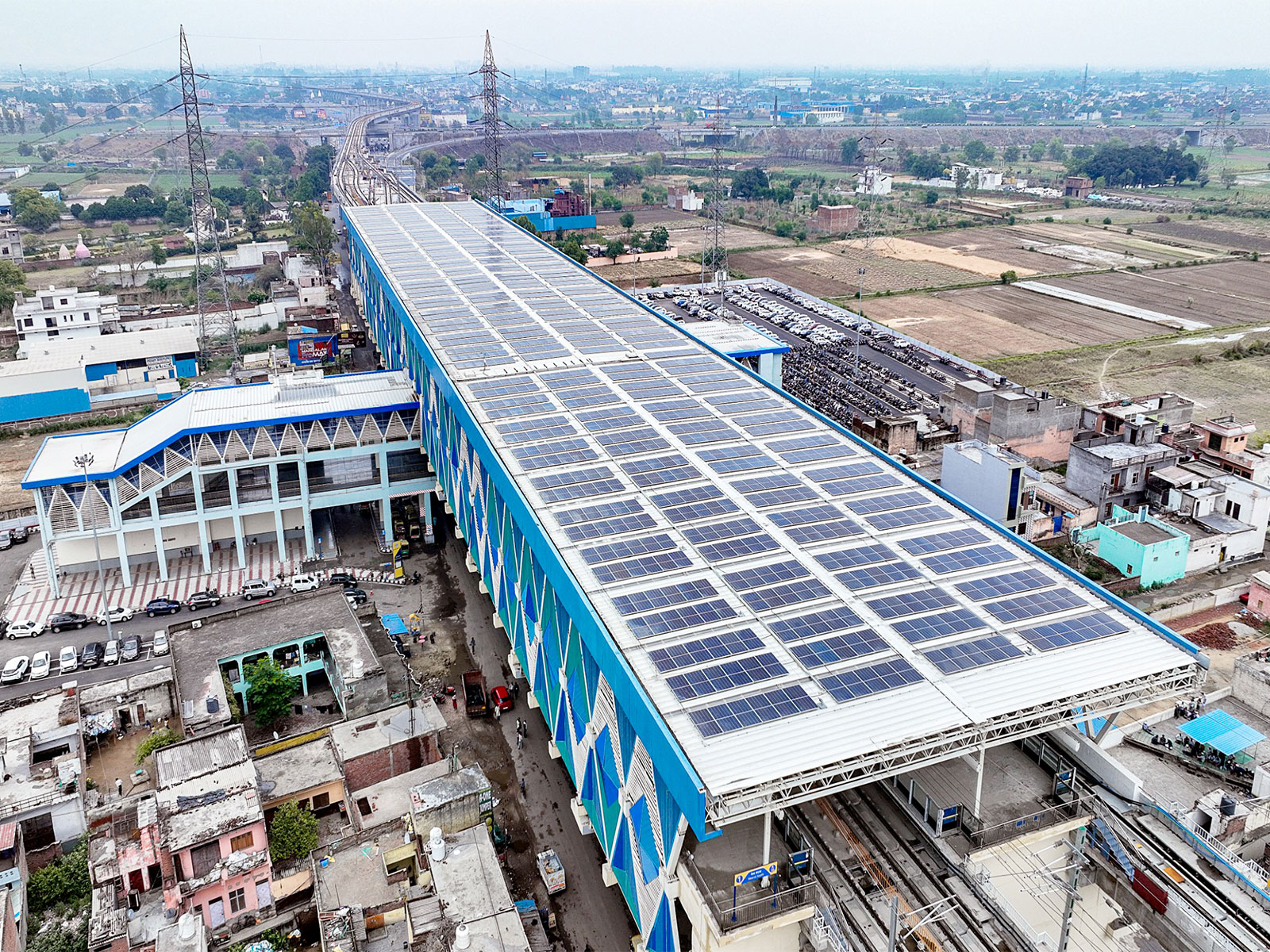
- 27 Oct 2025
In News:
India’s renewable energy journey has evolved from an era of rapid capacity expansion to one focused on creating a stable, resilient, and system-integrated clean energy ecosystem. With a target of 500 GW of non-fossil capacity by 2030, the country is moving from quantity to quality—shifting from mere capacity addition to building institutional, technical, and infrastructural strength capable of sustaining long-term decarbonisation.
Progress and Current Landscape
Over the past decade, India’s renewable energy capacity (excluding large hydro) has grown from around 35 GW in 2014 to over 197 GW in 2025, making it one of the world’s fastest-growing clean energy markets. The country continues to add 15–25 GW annually, driven by solar, wind, and hybrid installations. However, this phase of “rapid expansion” has revealed structural challenges — inadequate grid capacity, financing gaps, and the need for skilled manpower — necessitating a pivot toward “capacity absorption” and system integration.
From Speed to System Strength
The Ministry of New and Renewable Energy (MNRE) has emphasized that India’s renewable growth story is entering a new phase centered on system reliability, grid integration, and financial discipline. The focus now lies in synchronising renewable generation with transmission infrastructure, market mechanisms, and energy storage.
India’s grid is being reimagined through a ?2.4 lakh crore Transmission Plan for 500 GW, connecting renewable-rich states like Rajasthan, Gujarat, and Ladakh with industrial and urban demand centers. The Green Energy Corridors and planned High Voltage Direct Current (HVDC) transmission lines are expected to unlock over 200 GW of new capacity. The CERC’s 2025 General Network Access (GNA) regulations, introducing dynamic “solar-hour” and “non-solar-hour” access, will further optimise grid use and reduce congestion.
Building Institutional and Human Capacity
Capacity building in renewable energy involves strengthening human, institutional, and technical systems to manage grid variability, storage integration, and emerging technologies like offshore wind and green hydrogen. Institutions such as the National Institute of Solar Energy (NISE) and State Nodal Agencies (SNAs) are training engineers and regulators, while international collaborations with IRENA and GIZ are enhancing India’s technical knowledge base.
At the policy level, reforms such as Production-Linked Incentive (PLI) schemes for solar modules, domestic content requirements, and duties on imported cells are deepening India’s manufacturing ecosystem, reducing import dependence, and enhancing competitiveness.
Innovation and Market Mechanisms
India’s renewable transition is increasingly driven by hybrid projects, Round-the-Clock (RTC) renewable energy, battery energy storage systems (BESS), and Virtual Power Purchase Agreements (VPPAs). These innovations ensure dispatchable power, attract private capital, and strengthen market-based renewable trading. Additionally, the National Green Hydrogen Mission is linking renewables to industrial decarbonisation, while distributed solar and agrovoltaic projects under PM Suryaghar and PM KUSUM are expanding rural participation in the clean energy transition.
Challenges and the Way Forward
India faces challenges including skill shortages, limited training infrastructure, financing constraints, and coordination gaps among multiple agencies. Rapid technological evolution demands continuous upskilling and institutional flexibility. Financial reforms, transmission readiness, and greater private sector participation will be key to sustaining the current momentum.
Conclusion
India’s renewable energy story is maturing—from a race for capacity to a strategy for endurance. Policy focus has shifted from expansion to integration, ensuring that the next growth phase is more stable, dispatchable, and sustainable. By aligning infrastructure, innovation, and institutions, India is laying the foundation for a resilient 500 GW clean energy system by 2030, driving its march toward Viksit Bharat and global climate leadership.
16th BRICS Summit 2025

- 26 Oct 2025
In News:
- Prime Minister Narendra Modi attended the 16th BRICS Summit, hosted by Russia in Kazan, under the theme “Strengthening Multilateralism for Just Global Development and Security.”
- The summit brought together leaders from Brazil, Russia, India, China, and South Africa, alongside newly inducted members such as Egypt, Ethiopia, Iran, Saudi Arabia, and the United Arab Emirates, reflecting the bloc’s expanding global footprint.
Background and Evolution of BRICS
- The BRICS grouping originated as BRIC in 2006 following the St. Petersburg meeting between Russia, India, and China, and was later formalized at the Yekaterinburg Summit (2009).
- South Africa joined in 2011, transforming BRIC into BRICS.The most recent expansion in 2024 added five new members, representing a major step toward inclusivity and a stronger collective voice for the Global South.
Initially comprising 42% of the world’s population, 30% of global land area, 23% of GDP, and 18% of global trade, the expanded BRICS seeks to reshape global economic governance and reduce dependence on Western-led institutions.
Objectives and Role
The alliance aims to:
- Promote reform of multilateral institutions such as the UN, IMF, and World Bank to reflect contemporary global realities.
- Foster economic cooperation, technology sharing, and sustainable development.
- Strengthen South-South cooperation and enhance the collective influence of emerging economies in global decision-making.
- Advocate a multipolar world order grounded in equity and mutual respect.
Key Outcomes and Agenda of the 16th Summit
The Kazan summit focused on:
- Financial Independence from Western Systems: Members discussed reducing reliance on the US dollar and the SWIFT network, particularly after sanctions on Russia post-Ukraine conflict.
Countries are increasingly exploring local currency settlements, currency swaps, and building alternative payment systems. - Economic and Development Cooperation: Review of the functioning of the New Development Bank (NDB), which has financed projects worth billions in renewable energy, infrastructure, and social sectors.
The Contingent Reserve Arrangement (CRA), with a reserve pool of $100 billion, continues to serve as a financial safety net. - Multilateral Reform and Climate Action: Discussions focused on reforming global institutions, promoting resilient supply chains, and strengthening collective action against climate change.
- Technology and Innovation: Members emphasized cooperation in science, innovation, and digital connectivity, enhancing research partnerships through the BRICS Science, Technology, and Innovation Framework.
India’s Priorities
Prime Minister Modi highlighted India’s role as a bridge between the Global South and developed economies. India’s agenda included:
- Strengthening reformed multilateralism and inclusive growth models.
- Deepening economic and technological collaboration within the bloc.
- Promoting people-to-people exchanges and cultural cooperation to enhance mutual understanding.
The visit also reinforced the Special and Privileged Strategic Partnership between India and Russia, marking PM Modi’s second visit to Russia in 2025.
Kazan: Symbolism and Significance
- The summit venue, Kazan, often referred to as Russia’s “third capital”, represents the country’s multi-ethnic and multi-religious identity.
- Located at the confluence of the Volga and Kazanka rivers, Kazan is the capital of Tatarstan and a thriving centre of petrochemicals, IT, and defence industries.
- Its diverse cultural fabric—home to both Orthodox cathedrals and Islamic mosques—embodies Russia’s pluralism and outreach to the Islamic world.
Challenges Ahead
Despite its achievements, BRICS faces internal and external challenges:
- Economic asymmetry among members, with China’s dominance occasionally causing unease.
- Geopolitical frictions, particularly between India and China, complicate consensus-building.
- Slow institutional reforms due to entrenched global power structures.
- Divergent foreign policy orientations toward the West among members.
Conclusion
The 16th BRICS Summit in Kazan reaffirmed the bloc’s commitment to a multipolar, equitable, and inclusive global order.
By advancing financial autonomy, technological cooperation, and institutional reform, BRICS continues to evolve as a platform for the Global South to assert its collective voice.
For India, it remains a vital forum to shape global governance, enhance strategic partnerships, and strengthen its vision of “VasudhaivaKutumbakam”—the world as one family.
Labelling AI-Generated Content in India: Towards Responsible Digital Governance
- 25 Oct 2025
In News:
The Ministry of Electronics and Information Technology (MeitY) has proposed amendments to the Information Technology (Intermediary Guidelines and Digital Media Ethics Code) Rules, 2021, mandating the labelling and disclosure of AI-generated content on social media platforms. The move comes amid growing public concern over deepfakes and synthetic media, which have begun to challenge democratic discourse, individual privacy, and digital trust.
The Rise of AI-Generated Content and Deepfake Concerns
India is experiencing a rapid surge in the use of artificial intelligence (AI) for content creation across entertainment, advertising, and online communication. However, this technological boom has also led to the proliferation of deepfakes — hyper-realistic videos, images, and audio clips generated by AI that mimic real individuals or events.
The issue gained national prominence in 2023, when a manipulated video of a popular actor went viral, prompting outrage and prompting Prime Minister Narendra Modi to call deepfakes a new “crisis.” These incidents have exposed how synthetic content can be weaponised for political propaganda, misinformation, financial fraud, and reputational harm.
Key Provisions of the Draft Rules
The proposed amendments introduce a comprehensive framework to enhance transparency and accountability in digital content creation:
- Mandatory Self-Declaration:Users uploading content on platforms such as YouTube, Instagram, or X (formerly Twitter) must declare whether their material is AI-generated or synthetic.
- Dual Labelling Mechanism:
- Embedded Label: AI-generated visuals and audio must carry a visible watermark or label covering at least 10% of the surface area or duration.
- Platform-Level Label: A visible disclaimer will appear wherever such content is displayed online.
- Platform Accountability:If users fail to disclose synthetic content, platforms must proactively detect and label it using AI-based detection tools. Non-compliance could lead to loss of safe harbour protection under Section 79 of the IT Act, making intermediaries legally liable for misinformation.
- Metadata Requirement:AI-generated material must include a permanent, traceable metadata identifier embedded at the time of creation to ensure accountability.
- Scope of Application:The rule extends beyond social media to AI content generation tools like OpenAI’s Sora and Google’s Gemini, requiring built-in watermarking mechanisms.
Rationale and Policy Objectives
The policy aims to ensure that users in a democracy can distinguish between authentic and synthetic content. By mandating labelling and traceability, the government seeks to curb misinformation, protect democratic integrity, and uphold public trust in the digital ecosystem.
The ministry’s note emphasizes that AI-generated misinformation poses risks to national security, elections, and social stability, making proactive governance essential. Previously, such misuse was addressed under general impersonation and fraud provisions of the IT Act, 2000, but the evolving sophistication of generative AI tools now demands specific regulatory safeguards.
Global Context
India’s initiative aligns with global best practices.
- China (2025): Introduced mandatory AI labelling for deepfakes, voice synthesis, and chatbots with visible and hidden watermarks.
- European Union: Under its AI Act, mandates user notification when interacting with AI systems.
- United States: Developing federal standards for content authenticity and AI watermarking.
By adopting a binding legal framework, India positions itself among the early regulators of generative AI, setting a precedent for responsible innovation.
Implementation Challenges and the Way Forward
While the proposal has been broadly welcomed, challenges persist. Detecting AI-generated content across diverse languages and formats requires sophisticated detection infrastructure. Excessive compliance burdens may also affect startups and smaller creators in India’s expanding $12 billion AI ecosystem.
The government has invited public and industry feedback until November 6, 2025, signaling openness to iterative policy design. Successful implementation will depend on multi-stakeholder cooperation, technological innovation, and digital literacy among users.
Conclusion
The proposed amendments mark a decisive shift in India’s digital governance—from reactive moderation to preventive transparency. By mandating AI content labelling, India aims to balance technological innovation with ethical responsibility, ensuring that the age of artificial intelligence strengthens rather than undermines truth, democracy, and public trust.
Scheme to Attract ‘Star Faculty’ Amid Global Academic Shifts
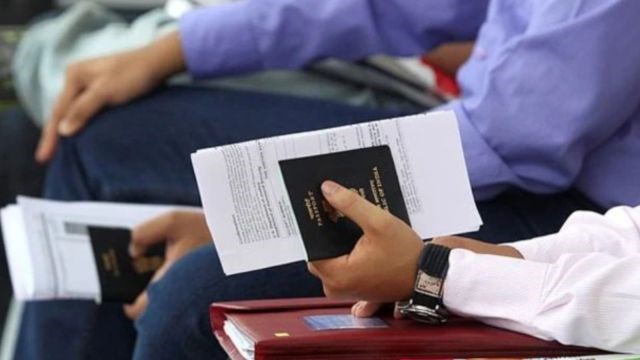
- 24 Oct 2025
In News:
India is formulating an ambitious new scheme to attract Indian-origin “star faculty” and researchers working in global universities to return and contribute to its domestic research and innovation ecosystem. The initiative, under discussion between the Principal Scientific Adviser’s Office, the Department of Higher Education, and the Departments of Science and Technology (DST) and Biotechnology (DBT), reflects the government’s push to position India competitively in the global race for scientific and academic excellence.
Background: India’s Research Landscape
- India has a strong tradition in science and higher education through premier institutions like the Indian Institutes of Technology (IITs), Indian Institutes of Science Education and Research (IISERs), and national laboratories under the DST and DBT. However, the country faces persistent challenges in retaining and attracting top global talent.
- India’s R&D expenditure remains around 0.7% of GDP, much lower than that of the U.S. (2.8%) and China (2.4%). Coupled with bureaucratic hurdles, modest salaries, and limited research autonomy, these factors have led to a steady outflow of skilled scientists and academics, often referred to as “brain drain.”
- Existing programmes such as the Visiting Advanced Joint Research (VAJRA) Faculty Scheme, Ramanujan Fellowship, and Ramalingaswami Re-entry Fellowship have attempted to link overseas Indian scholars with domestic institutions. However, participation has remained limited, prompting the need for a more comprehensive and long-term mechanism.
Key Features of the Proposed Scheme
The Star Faculty Scheme seeks to attract established Indian-origin researchers with strong academic and scientific credentials to work full-time or for extended periods in Indian institutions.
1. Targeted Recruitment:The initiative will focus on 12–14 strategic areas in science, technology, engineering, and mathematics (STEM) deemed vital for national capacity-building.
2. Financial and Institutional Incentives:Returning scholars are likely to receive substantial one-time set-up grants to establish laboratories and research teams. Institutions like the IITs have expressed support for providing operational flexibility and research autonomy.
3. Red-Carpet Ecosystem:The scheme aims to minimize bureaucratic delays by offering streamlined processes for housing, administrative support, and project funding. Experts emphasize that beyond salaries, a “red-carpet” experience—ease of living and working—is critical to attracting global talent.
4. Collaborative Networks:It will promote inter-institutional linkages between Indian and foreign universities, ensuring long-term collaboration rather than short-term exchanges.
5. Light-Touch Oversight and IP Clarity:A balanced governance framework will ensure academic freedom, transparent intellectual property ownership, and minimal reporting burdens, aligning with global research practices.
Global Context
The initiative comes amid significant shifts in global academia. In the United States, policies like the “Compact for Academic Excellence in Higher Education” under the Trump administration have tightened regulations on international students, race-based admissions, and university autonomy. Critics view these as constraints on academic freedom, prompting uncertainty among foreign faculty—including those of Indian origin.
Simultaneously, Europe is moving to enshrine academic freedom in law, while China and Taiwan continue to expand well-funded recruitment drives to attract overseas researchers. India’s new scheme aims to leverage this shifting academic landscape to bring back its global talent pool.
Structural Challenges
Experts highlight that India’s ability to compete globally will depend on addressing systemic issues:
- Non-competitive pay: A full professor in India earns roughly USD 38,000 annually, compared with USD 130,000–200,000 in the U.S. and USD 100,000 in China.
- Infrastructure gaps: Many universities still lack advanced laboratories and research autonomy.
- Bureaucratic hurdles: Lengthy approval processes discourage international collaboration.
The new programme aims to overcome these through multi-year appointments, flexible tenure, and transparent evaluation mechanisms.
Way Forward
If executed effectively, the Star Faculty Scheme could reverse the brain drain, strengthen India’s knowledge economy, and foster innovation-led growth. It can bridge the gap between academia and industry, promote technology transfer, and develop globally connected research ecosystems.
By offering world-class conditions, trust-based governance, and institutional flexibility, India has the opportunity to reimagine its academic landscape, positioning itself as a global hub for scientific talent and innovation in the 21st century.
Status of Elephants in India: New Census Establishes a Scientific Baseline for Conservation
- 23 Oct 2025
In News:
The Wildlife Institute of India (WII) has released its report titled “Status of Elephants in India”, marking a new chapter in the country’s elephant conservation efforts. The study estimates 22,446 elephants across four major landscapes — the first time a DNA-based census method has been used. Although the figure appears lower than the 2017 estimate of 29,964 elephants, experts clarify that this does not represent a population decline but a fresh scientific baseline for future monitoring.
Evolution of Elephant Population Estimation in India
India’s elephant counts have evolved significantly since the first census in 1929 in the then United Province (now Uttar Pradesh and Uttarakhand). Early surveys relied on direct visual counts and averaging of sightings. With the launch of Project Elephant in 1992, the estimation process became more structured, with five-yearly assessments using methods such as total count, dung count, and transect sampling.
However, since different States adopted varied techniques, results were often inconsistent and incomparable. To overcome this, synchronised elephant censuses were conducted in 2005, 2010, and 2017 using uniform methods like total count and line transect dung count, but observer bias and overcounting remained major issues.
Recognising these limitations, India adopted a new scientific framework under the Synchronous All-India Elephant Estimation (SAIEE) 2021–25, shifting from visual to genetic sampling for more accurate and comparable results.
SAIEE 2021–25: A Scientific Overhaul
The SAIEE 2021–25 represents the most comprehensive and methodologically advanced elephant census in India. The country was divided into 100 sq. km cells, further split into 4 sq. km grids, each uniquely coded to ensure spatial accuracy. Enumerators covered over 6.6 lakh km, surveying nearly 1.9 lakh transects, and collected 21,056 dung samples for DNA extraction.
The census was carried out in three phases:
- Field data collection on animal signs, dung, vegetation, and human disturbances.
- Habitat and human impact assessment, including forest cover and patch size.
- Spatial abundance modelling using habitat and human interface data.
This shift to DNA-based identification eliminates duplication errors, allowing scientists to create a uniform national baseline for long-term monitoring and conservation.
Findings: The Landscape of Elephants
The report identifies four major elephant-bearing regions in India:
- Western Ghats (Karnataka, Kerala, Tamil Nadu) – The strongest habitat, hosting 11,934 elephants (53%), with Karnataka alone having 6,013.
- North Eastern Hills and Brahmaputra Flood Plains – About 22% of the national population, led by Assam with 4,159 elephants.
- Shivalik Hills and Gangetic Plains – Around 9%, mostly in Uttarakhand.
- Central India and Eastern Ghats – About 8%, with Odisha as a key habitat.
This highlights the Western Ghats as India’s most critical elephant stronghold, while the Northeast remains vital for transboundary populations.
Emerging Challenges: Fragmentation and Conflict
The report warns that habitat fragmentation due to commercial plantations, mining, linear infrastructure, and encroachments is severely impacting elephant movement. This has triggered increasing human-elephant conflict, as herds venture into new areas in search of food and connectivity.
In Karnataka, Tamil Nadu, and Kerala — which together host the majority of India’s elephants — conflicts have led to hundreds of human and elephant fatalities. Similar patterns are emerging in Andhra Pradesh and parts of central India, where elephants have recolonised regions after nearly two centuries.
Conservation Outlook
Experts emphasise that habitat connectivity and coexistence must be central to future conservation strategies. The new DNA-based baseline offers a reliable foundation for policy interventions, habitat restoration, and conflict mitigation.
Community participation, awareness programmes, and integration of Elephant Corridors under Project Elephant are essential to ensure long-term survival of Elephas maximus in India.
Conclusion
India’s transition to a DNA-based elephant census marks a scientific milestone in wildlife monitoring. While the numbers suggest a smaller population than before, the shift represents a more precise and globally aligned approach to conservation. With over half of Asia’s elephants residing in India, the findings of the WII’s study underscore an urgent need to balance development with ecological sensitivity, ensuring that India’s national heritage animal continues to thrive in its natural habitats.
Government’s Strategy to Boost Defence Exports and Domestic Manufacturing

- 22 Oct 2025
In News:
Defence Minister Rajnath Singh recently announced the government’s target to expand India’s defence manufacturing ecosystem to a valuation of ?3 lakh crore and enhance defence exports to ?50,000 crore by 2029.This marks a significant step in India’s vision of transforming from the world’s largest arms importer to a global defence manufacturing and export hub.
About the Initiative
The plan represents a strategic roadmap to strengthen India’s indigenous defence production base while increasing global competitiveness. It aligns with the objectives of Atmanirbhar Bharat and Make in India initiatives in the defence sector.
Key Features and Focus Areas
1. Private Sector Integration
- Encouraging partnerships between private defence manufacturers, Defence Research and Development Organisation (DRDO), and Defence Public Sector Undertakings (DPSUs).
- Collaboration with foreign Original Equipment Manufacturers (OEMs) to facilitate joint ventures, co-development, and technology transfer.
- Promoting participation in the Defence Industrial Corridors in Uttar Pradesh and Tamil Nadu to attract domestic and foreign investment.
2. Indigenisation of Defence Platforms
- Expanding indigenous production of major systems such as:
- LCA Tejas fighter aircraft
- Akash surface-to-air missiles
- Pinaka multi-barrel rocket launchers
- Advanced Light Helicopters (ALH) and Arjun tanks.
- Focus on import substitution through locally developed components, sensors, and sub-systems.
3. Policy and Regulatory Reforms
- Simplification of defence procurement procedures (DPP) and Defence Acquisition Procedure (DAP) to ensure faster clearances.
- Streamlined export licensing and authorisation through a single-window system.
- Incentivisation under Make-I, Make-II, and iDEX (Innovations for Defence Excellence) programmes.
- Enhanced funding for start-ups and MSMEs in defence innovation under the Technology Development Fund (TDF).
4. Skill Development and Research
- Establishment of specialised defence education and skilling institutes, such as Symbiosis Skills and Professional University, to build a trained workforce.
- Promotion of R&D collaboration between academia, industry, and DRDO to accelerate innovation in next-generation technologies like AI, robotics, and autonomous systems.
5. Operational Validation
- Indigenous systems have been successfully deployed in real operations—such as Operation Sindoor, which demonstrated the combat readiness and reliability of domestically produced defence equipment.
- Strengthening of quality assurance and field validation processes to enhance global trust in Indian defence products.
Strategic Significance
- Economic Growth:The initiative will boost industrial output, exports, and employment, contributing to India’s defence industrial self-reliance and GDP growth.
- Global Competitiveness:Positions India as a net defence exporter, catering to friendly nations in Asia, Africa, and Latin America.
- National Security:Reduces dependence on foreign arms imports and enhances strategic autonomy in critical technologies.
- Technological Innovation:Encourages indigenous innovation and the development of dual-use technologies benefiting both defence and civilian sectors.
- Geopolitical Leverage:Expanding defence exports strengthens India’s diplomatic ties through defence diplomacy and builds strategic partnerships with friendly nations.
Challenges Ahead
- Need for faster project implementation and clearer export procedures.
- Addressing R&D funding gaps and improving private sector participation.
- Ensuring competitive pricing and quality to meet global standards.
- Streamlining coordination among MoD, DRDO, DPSUs, and private players.
Way Forward
- Promote joint ventures with global defence majors to enhance technology absorption.
- Strengthen testing and certification infrastructure to meet international benchmarks.
- Expand defence offset policies to attract advanced technologies.
- Encourage defence start-ups and innovation clusters for rapid prototyping and scalable production.
Conclusion
India’s ambitious target to achieve ?3 lakh crore in defence production and ?50,000 crore in exports by 2029 reflects a paradigm shift toward self-reliance, innovation, and global competitiveness in defence manufacturing.
With sustained policy reforms, technological investment, and industry-academia synergy, India is well-positioned to emerge as a reliable global supplier of advanced defence systems and a pillar of regional security.
Poverty Measurement in India: Revisiting the Rangarajan Line and the Rise of Multidimensional Poverty
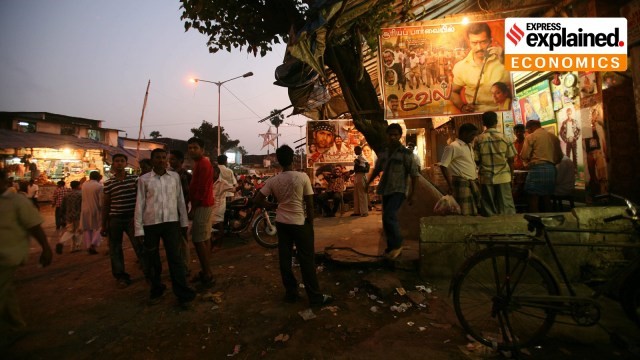
- 21 Oct 2025
In News:
The debate on poverty measurement in India has gained renewed significance with the Reserve Bank of India’s Department of Economic and Policy Research (DEPR) updating state-wise poverty estimates using the 2022–23 Household Consumption Expenditure Survey (HCES). This marks the first major recalibration of the C. Rangarajan Committee’s poverty line, originally formulated in 2014, and reflects shifting paradigms in assessing deprivation in India.
Revisiting the Rangarajan Framework
The Rangarajan Committee was tasked with redefining poverty beyond the earlier Tendulkar methodology. It fixed the poverty line at ?972 per capita per month in rural India and ?1,407 in urban areas (2011–12 prices), categorising about 29.5% of the population as poor. Its poverty basket focused on minimum nutritional requirements along with basic spending on health, education, fuel, clothing, and rent. Unlike later approaches, it offered a strict consumption-based benchmark rooted in monetary expenditure.
Updated Poverty Trends: State-wise Insights
RBI economists reconstructed poverty lines for 20 major states based on HCES 2022–23 data using a new price index aligned with the original poverty line basket rather than Consumer Price Index weights. The findings highlight remarkable improvements, with major reductions observed in traditionally backward states:
- Odisha: Rural poverty fell from 47.8% (2011–12) to 8.6% (2022–23)
- Bihar: Urban poverty dropped from 50.8% to 9.1%
- Kerala: Rural poverty declined to 1.4%; Himachal Pradesh’s urban poverty fell to 2%
- Lowest poverty levels: Rural Himachal Pradesh (0.4%) and urban Tamil Nadu (1.9%)
- Highest poverty levels: Chhattisgarh (25.1% rural; 13.3% urban)
These transformations reflect improved rural infrastructure, livelihood programmes, PDS reforms, and social transfers. Yet persistent poverty in central Indian states underscores uneven development and structural gaps in employment quality, agrarian distress, and welfare delivery.
Methodological Continuity and Debate
Poverty estimates vary sharply across institutions, illustrating the sensitivity of measurement frameworks:
- SBI (2023–24): ~4–5% poverty
- World Bank (2022): 10.2% poverty in 2019
- IMF (2022): 0.8% in 2019 (including food transfers)
These disparities stem from differing inflation adjustments, survey datasets, and treatment of welfare subsidies. They also fuel a longstanding debate: can income-based poverty capture human deprivation comprehensively, especially in a transforming economy with evolving consumption patterns?
Shift to Multidimensional Poverty
Official focus has now decisively shifted to multidimensional poverty aligned with SDG frameworks. India’s Multidimensional Poverty Index (MPI) evaluates deprivation across twelve indicators spanning health, education, and living standards. According to NITI Aayog (2024), 24.82 crore people exited multidimensional poverty between 2013–14 and 2022–23, reducing MPI from 29.17% to 11.28%. This highlights the impact of welfare architecture—PDS expansion, Ujjwala, Saubhagya, Jal Jeevan Mission, Swachh Bharat, and financial inclusion.
Way Forward
- Regular poverty line updates reflecting new consumption patterns and regional price realities
- Integration of income and multidimensional metrics for balanced welfare planning
- Timely survey releases and transparent data to strengthen evidence-based policymaking
- Targeted interventions for lagging states like Chhattisgarh, Jharkhand, and parts of UP
- Leveraging digital delivery systems to minimise leakages and enhance inclusivity
Conclusion
India’s poverty trajectory reflects a dual narrative—sharp improvements driven by welfare provisioning and growth, yet uneven progress across regions and methodological contestation. While the Rangarajan line continues to serve as a benchmark for monetary poverty, the dominance of multidimensional metrics signals a shift towards understanding deprivation as a matter of human capability, not merely income. Ensuring sustained and equitable poverty reduction will require methodological rigor, policy innovation, and heightened focus on lagging geographies to achieve inclusive development.
Google’s $15 Billion AI Data Centre in Andhra Pradesh
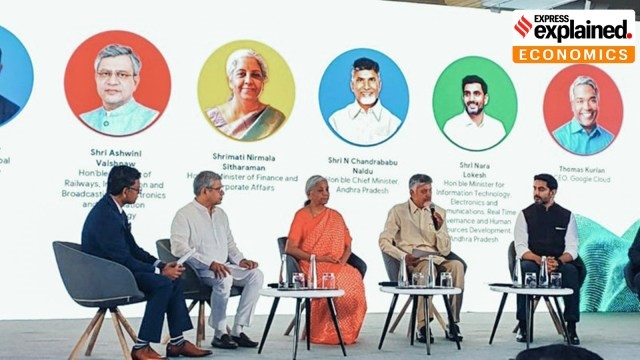
- 18 Oct 2025
In News:
Google’s announcement of a USD 15-billion investment to establish an Artificial Intelligence (AI) data centre in Visakhapatnam marks a transformational moment in India’s digital infrastructure landscape. The initiative, the largest single investment by Google in India, comes amid a geo-economic context of recalibrating India-US relations and the government’s emphasis on technological self-reliance and swadeshi digital systems. The project positions India as an emerging hub in global AI capability and computing power.
Why AI Data Centres Matter
AI-focused data centres differ fundamentally from conventional facilities. While traditional data centres are built around CPU-based servers to support cloud storage, websites, and enterprise applications, AI data centres rely on high-performance GPUs to handle data-heavy and compute-intensive workloads such as generative AI, advanced analytics, image/video processing, and deep-learning models. This makes them significantly more power-intensive and infrastructure-demanding, requiring robust energy supply and advanced cooling systems.
According to estimates cited by Google, the Visakhapatnam AI hub is expected to add at least USD 15 billion to the US GDP between 2026 and 2030 through increased AI adoption and cloud-driven activity, demonstrating the cross-border economic impact of such investments.
Partnerships and Green Infrastructure
The facility is being developed in partnership with AdaniConneX and Airtel, leveraging the same backbone used for Google’s global platforms like Search, YouTube, and Workspace. The project includes building a major subsea cable landing station, linking eastern India to Google’s expansive global cable network, enhancing international data routes and reducing latency.
A key dimension of the partnership lies in sustainable power and energy independence. AdaniConneX, a joint venture between Adani Enterprises and EdgeConneX, will provide 100% clean energy, supported by new transmission lines, renewable generation, and energy storage facilities in Andhra Pradesh. This aligns with India’s climate commitments and enhances grid resilience.
Economic Impact and Capacity Expansion
India’s data centre industry, currently valued at ~USD 10 billion with USD 1.2 billion in FY24 revenue, is projected to add 795 MW of capacity by 2027 — reaching 1.8 GW. Google’s project alone is expected to generate nearly 1.88 lakh direct and indirect jobs, strengthening regional development and high-skilled employment.
However, high capital costs and limited job intensity remain policy concerns. Approximately 40% of capex in data centres goes towards electrical systems, and 65% of operating costs are attributed to electricity, with ~?60–70 crore required per MW of capacity. This necessitates a careful assessment of incentives and long-term strategic benefits.
Energy Security and the Nuclear Option
The International Energy Agency (IEA) predicts that global data-centre electricity demand may double by 2026, raising questions around sustainability. While renewable energy remains the mainstay, its intermittency has prompted policy consideration of nuclear energy as a round-the-clock clean power source — a trend already visible in the United States and now emerging in India’s energy strategy.
Conclusion
Google’s AI hub in Visakhapatnam represents a strategic convergence of digital infrastructure, clean-energy innovation, and global technological cooperation. For India, it underscores the dual challenge of expanding digital capability while ensuring energy security and environmental sustainability. The success of this initiative will influence India’s journey toward becoming a global digital superpower underpinned by resilient, sovereign, and sustainable compute ecosystems.
India’s First DNA-Based Elephant Census: Population Declines, New Scientific Baseline Established
- 17 Oct 2025
In News:
- India has released the results of its first-ever DNA-based elephant population assessment under the Synchronous All-India Elephant Estimation (SAIEE) 2021–25.
- The report estimates 22,446 wild elephants, marking an 18% decline from the 2017 figure of 27,312. However, the government stresses that the numbers are not directly comparable due to a shift to a more advanced, genetic mark-recapture methodology, establishing a new population baseline.
Significance of Elephants in India
- India hosts over 60% of the global Asian elephant population, making it critical to the species’ global survival.
- Elephants are Keystone species, maintaining forest ecosystem health.
- They are deeply woven into Indian cultural, religious, and ecological heritage.
Distribution
Elephants in India inhabit four major landscapes:
|
Region |
Estimated Population (2025) |
|
Western Ghats |
11,934 (largest population) |
|
North Eastern Hills & Brahmaputra Floodplains |
6,559 |
|
Shivalik Hills & Gangetic Plains |
2,062 |
|
Central India & Eastern Ghats |
1,891 |
Top States (2025)
- Karnataka: 6,013
- Assam: 4,159
- Tamil Nadu: 3,136
- Kerala: 2,785
- Uttarakhand: 1,792
- Odisha: 912
These states collectively support over 80% of India’s elephant population.
How the DNA-Based Census Was Conducted
This was India’s most comprehensive elephant survey to date, combining:
- DNA fingerprinting of dung samples
- Satellite mapping
- Ground-based habitat surveys
Key Technical Inputs
- ~21,000+ dung samples collected across 20 states
- 4,065 individual elephants genetically identified
- Forests divided into 100 sq km grids, further sub-divided for finer sampling—adapted from India’s tiger census model
- Survey covered 6.7 lakh km of forest trails and 3.1 lakh dung plots
This non-invasive method is statistically robust compared to earlier sighting-based estimates.
Key Findings
- Estimated Population: 22,446 (range: 18,255 – 26,645)
- Western Ghats largest stronghold
- Population decline observed, though partly attributed to more accurate methodology
- Significant habitat fragmentation and corridor disruption noted
Major Threats
- Habitat loss & fragmentation from agriculture, mining, infrastructure and linear projects
- Human-elephant conflict leading to casualties on both sides
- Poaching and retaliatory killings
- Disruption of migration corridors by rail lines, highways, power fences
- Invasive species and land-use change (especially Western Ghats and Northeast)
Legal Protection & Conservation Measures
- Status: Endangered (IUCN)
- Legal Protection: Schedule I — Wildlife (Protection) Act, 1972; Appendix I — CITES
- Key Initiatives
- Project Elephant (1992)
- 101 Elephant Corridors Programme
- Gaj Yatra Awareness Campaign
- Use of technology: satellite tracking, GIS, camera traps, M-STRiPES-like monitoring
The government is now working on Project Elephant 2.0 to strengthen habitat connectivity and conflict mitigation through community-based conservation.
Significance of the New Baseline
- Establishes a scientific foundation for long-term population monitoring
- Enables integration of genetic, ecological & spatial data
- Aligns with global best practices in wildlife conservation
- Crucial for revising policies on corridor protection, land-use planning, and conflict reduction
2025 Nobel Prize in Economic Sciences: Understanding Innovation-Driven Growth
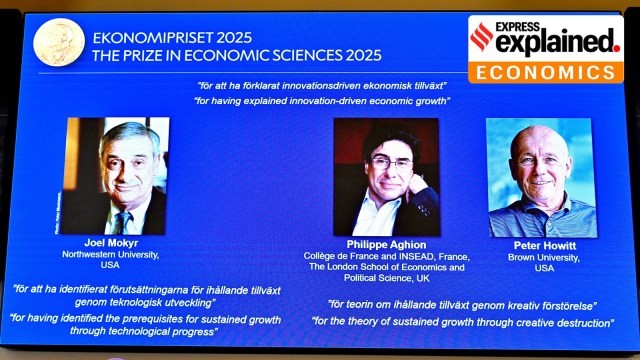
- 16 Oct 2025
In News:
The 2025 Nobel Prize in Economic Sciences has been awarded to Joel Mokyr, Philippe Aghion, and Peter Howitt for their seminal contributions to explaining how innovation drives long-term economic growth. Their work collectively answers a fundamental question in development economics: why has sustained growth become the norm in the last two centuries, despite millennia of stagnation? While Mokyr approaches the issue through economic history, Aghion and Howitt construct a formal model illustrating the dynamics of innovation and competition in modern economies.
Mokyr’s Framework: Useful Knowledge and Openness to Change
Joel Mokyr argues that economic stagnation persisted through most of human history because innovation lacked a strong scientific foundation. Prior to the Industrial Revolution, technological progress was primarily prescriptive—people knew how to produce goods but not why processes worked as they did. This limited systematic improvement.
The transformation began during the Scientific Revolution (16th–17th centuries) when controlled experimentation, measurement, and reproducibility became central to knowledge creation. This generated “useful knowledge”—a synergy of propositional (scientific principles) and prescriptive (practical techniques) knowledge. Examples include improvements in the steam engine driven by insights into atmospheric pressure and advancements in steel production based on understanding carbon reduction in iron.
However, knowledge alone was not sufficient. Societal openness to change, a hallmark of Enlightenment thought, enabled technological disruption. Acceptance of new ideas, weakening of entrenched elites, and institutional reforms—from the British Parliament curbing aristocratic privileges to society’s rejection of Luddite resistance to machinery—allowed innovations to diffuse widely. According to Mokyr, skills-based human capital and a culture supportive of disruption are crucial pillars of sustained growth.
Aghion–Howitt’s Creative Destruction Model
Drawing on Joseph Schumpeter’s concept of creative destruction, Aghion and Howitt develop a rigorous macroeconomic model explaining how innovation displaces old technologies and firms, generating productivity gains. Their model shows that firms invest in research and development (R&D) to secure temporary monopoly power through patents. This monopoly incentivizes innovation, yet it is continually threatened by newer technologies. Thus, growth emerges from a constant cycle of competition, firm turnover, and technological leaps.
Importantly, their general equilibrium framework links household savings, financial markets, production decisions, and innovation incentives, demonstrating that micro-level disruptions are essential for macro-level stability. Empirical trends—such as high annual firm entry and exit rates in developed economies—support their argument.
Policy Implications
The Nobel findings highlight key contemporary debates:
- R&D Subsidies: Innovation has positive spillovers beyond private profit. Public funding can correct under-investment, but excessive subsidies risk waste where gains are marginal.
- Social Safety Nets: Creative destruction benefits economies but harms displaced workers and firms. A balanced welfare ecosystem ensures societies remain open to technological change.
- Skilling and Human Capital: To convert ideas into output, governments must invest in education, vocational training, and research ecosystems.
Conclusion
The 2025 Nobel laureates collectively establish that economic growth is neither automatic nor guaranteed—it is the result of science-based knowledge creation, institutional openness, and dynamic competition. For emerging economies like India, fostering innovation-driven growth requires strong research systems, regulatory flexibility, investment in human capital, and social policies that cushion transition shocks. Their work underscores that sustainable progress lies in embracing change, not resisting it.
India’s Grain-Driven Ethanol Transition: Shifting Paradigms in Biofuel Policy
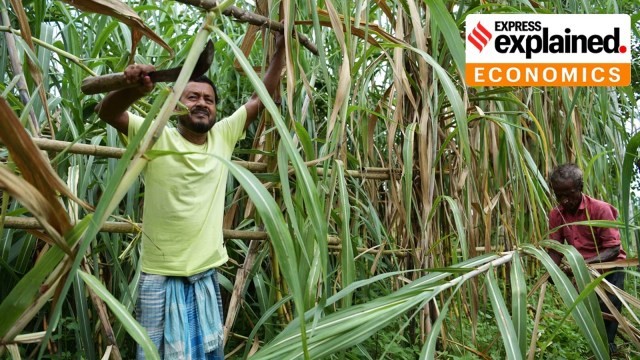
- 15 Oct 2025
In News:
India’s ethanol blending programme, originally launched to reduce oil imports and stabilise the sugar industry, is undergoing a transformative shift. What began as a sugarcane-centric initiative has evolved into a grain-based ethanol ecosystem, reflecting structural changes in agricultural markets, energy policy, and rural industrialisation. For the first time, grain-derived ethanol—predominantly from maize—has surpassed sugarcane-based production, marking a pivotal moment in India’s biofuel sector.
Evolution of Ethanol Blending
The Ethanol Blending Programme (EBP) was initially designed to create additional revenue streams for sugar mills and ensure timely payments to cane growers. Early production relied on C-heavy molasses, a by-product of sugar extraction. Policy reforms in 2018 incentivised diversion of B-heavy molasses and even direct cane juice toward ethanol, raising supplies from 38 crore litres in 2013-14 to nearly 189 crore litres by 2018-19, and increasing blending levels from 1.6% to nearly 5%. This stabilised the sugar economy and boosted rural incomes.
Rise of Grain-Based Ethanol
A crucial turning point came when the government permitted ethanol production from grains such as maize, rice, and damaged foodgrains, offering differential pricing to attract investment. Grain-based distilleries rapidly expanded across Punjab, Haryana, Bihar, Madhya Pradesh, Maharashtra, Karnataka, and other states, with over ?40,000 crore invested in facilities capable of using multiple feedstocks.
By 2023-24, of the 672.49 crore litres supplied to Oil Marketing Companies (OMCs), almost 60% came from grains, with maize accounting for the largest share. In 2024-25, grain-based ethanol procurement is expected to reach 620 crore litres, with maize alone contributing about 420 crore litres. Drought-induced sugarcane shortages and more attractive prices—?71.86 per litre for maize-based ethanol versus ?57.97–65.61 per litre for cane-based routes—accelerated the shift.
Capacity and Policy Dynamics
India today hosts 499 distilleries with an annual ethanol capacity of 1,822 crore litres. Against a 20% blending target, OMCs sought 1,050 crore litres for 2025-26, but received offers exceeding 1,776 crore litres—signalling emerging overcapacity. While this capacity enhances energy security and reduces crude imports (over $160 billion annually), it introduces new challenges in balancing supply, food security, and price stability.
Challenges: Food Security, Sustainability, and Market Balance
India now faces a classic food-versus-fuel dilemma. Producing ~420 crore litres of maize ethanol consumes over 11 million tonnes of maize, nearly 26% of national output. With maize being vital for poultry and livestock feed, diversion to fuel can raise feed costs and food inflation. Similarly, viability of rice-based ethanol hinges on surplus FCI stocks—an uncertain variable.
Environmental concerns are also emerging. While ethanol reduces carbon emissions, grain-based production increases pressure on water, land, and fertiliser use, particularly in maize-growing regions.
Way Forward
Policy refinements are underway to ensure a balanced biofuel strategy. A dual-feedstock approach—leveraging both cane and grains—along with scaling second-generation (2G) biofuels from agricultural waste, is expected to drive future growth. Adequate stock monitoring, sustainable cultivation practices, and technological innovation will be critical for achieving the 20% blending target by 2025-26 without compromising food security.
Conclusion
India’s ethanol revolution demonstrates strategic economic diversification, rural industrialisation, and commitment to energy transition. However, sustaining this momentum requires calibrated policies aligning energy security with agricultural sustainability, food availability, and environmental stewardship—critical considerations for a resilient and self-reliant biofuel future.
Gender-Affirming Care (GAC)

- 14 Oct 2025
In News:
India has witnessed significant legal milestones in recognising the rights of transgender and gender-diverse persons, most notably the NALSA v. Union of India (2014) judgement affirming gender self-identification and the Transgender Persons (Protection of Rights) Act, 2019. However, the lived reality of transgender communities remains marked by deep social exclusion, stigma, and poor health outcomes. Among these, mental health remains the most neglected dimension, despite clear evidence linking social affirmation and access to gender-affirming care (GAC) with substantial improvements in wellbeing.
The Mental Health Crisis
Transgender individuals face disproportionate psychological distress arising from discrimination, violence, marginalisation, and denial of identity. Recent national-level studies indicate that 31% of transgender persons in India have attempted suicide, nearly half before age 20. Rates of depression, anxiety, and self-harm are significantly higher than in the general population. Research globally—including evidence from JAMA Network Open (2023)—confirms that timely access to gender-affirming interventions markedly reduces gender dysphoria, suicidal ideation, and depression, while improving life satisfaction and functioning.
What Gender-Affirming Care Encompasses
Gender-affirming care is a continuum of social, medical, and psychological support that enables individuals to live in alignment with their gender identity. It ranges from basic respect for chosen names and pronouns to counselling, hormone therapy, and surgical interventions when desired. International bodies, including the World Health Organization, recognise GAC as medically necessary, not elective, owing to its direct link to mental and physical health. Importantly, GAC is rooted in dignity and self-determination—core to Article 21’s right to life and dignity under the Constitution of India.
Barriers to Access
Despite recognition in law, access to GAC in India remains severely limited:
- Scarce trained providers and absence of standardised national treatment protocols
- Financial barriers: surgeries costing ?2–?8 lakh and hormone therapies ?50,000–?70,000 annually
- Under-implementation of Ayushman Bharat TG Plus, with limited empanelled hospitals
- Stigma in healthcare settings leading to refusal of treatment or discriminatory behaviour
- Rising cases of unsupervised hormone use, causing serious health complications including organ damage
Policy blind spots also hinder progress; the absence of transgender-specific data in major surveys like NFHS and NSSO leads to exclusion from mainstream health planning and welfare schemes.
Societal and Health Consequences
When GAC is inaccessible, the consequences are profound—heightened mental illness, economic precarity, and social alienation. Research from Indian institutions such as TISS has documented widespread discrimination in healthcare settings, with 65% of trans youth reporting some form of refusal or mistreatment. Such systemic barriers reinforce cycles of poverty, homelessness, and deteriorating health.
Policy Priorities and Way Forward
Ensuring equitable access to gender-affirming care requires a rights-based, public health-driven framework. Key priorities include:
- Integrating GAC into Ayushman Bharat with free or subsidised access in public hospitals
- Establishing national clinical guidelines and training medical personnel in gender-affirming practice
- Strengthening trans-led community institutions for outreach, mental health support, and navigation
- Mandating inclusive insurance coverage for hormone therapy and surgeries
- Building robust data systems to guide policy and budget allocations
- Launching public sensitisation campaigns to combat stigma
- Replicating successful state models such as Tamil Nadu’s gender clinics and Kerala’s Transgender Cell
Conclusion
Gender-affirming care is fundamental to the right to health, dignity, and equality. India’s progress in legal recognition must now translate into accessible, affordable, and stigma-free health services. Achieving genuine mental health equity and social justice demands urgent integration of gender-affirming care into primary healthcare systems. Empowering transgender persons to live authentically is not merely a medical intervention—it is a constitutional and moral imperative for an inclusive, humane, and equitable India.
Credit Reforms to Deepen Financial Markets
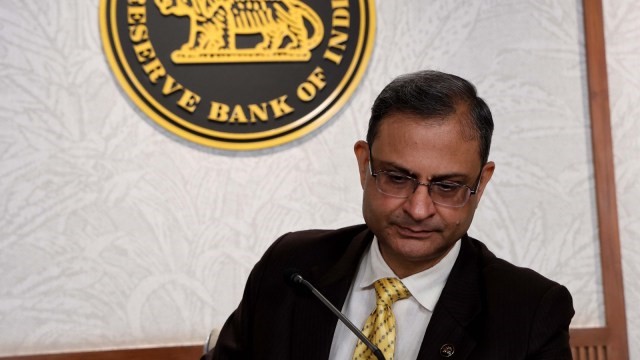
- 13 Oct 2025
In News:
India’s journey toward Viksit Bharat 2047 hinges on simultaneously nurturing human capital and modernising financial institutions. Two recent developments reflect this integrated approach: the Viksit Bharat Buildathon 2025 and the Reserve Bank of India’s initiatives to strengthen financial markets and internationalise the rupee. Together, they illustrate India's twin strategy of empowering youth as innovation leaders while deepening economic capacity and regional influence.
Fostering a Culture of Innovation: Viksit Bharat Buildathon 2025
- The Viksit Bharat Buildathon, launched by the Ministry of Education in collaboration with NITI Aayog’s Atal Innovation Mission, is India’s largest school-level hackathon, engaging 1 crore students across classes 6–12.
- Aligned with NEP 2020, it aims to build problem-solving aptitude and innovation competencies from grassroots levels. Students work in teams to design prototypes based on four themes central to India’s development discourse—Atmanirbhar Bharat, Swadeshi, Vocal for Local, and Samriddh Bharat.
- The event adopts a phased structure: registrations (September), nationwide live build on 13 October 2025, and final evaluation by December. With Rs 1 crore award pool and dedicated mentorship from innovation networks and higher education institutions, it incentivises early exposure to experiential learning, creativity, and entrepreneurship. Importantly, it prioritises participation from Aspirational Districts, tribal belts, and frontier regions, promoting inclusivity in innovation ecosystems.
- By integrating rural and underserved communities, the initiative aligns with the principle of technology-enabled social justice and fosters an innovation-ready workforce. It positions schoolchildren not merely as future beneficiaries but as current contributors to nation-building—a step crucial for demographic dividend utilisation.
Rewiring India’s Financial System: RBI’s Strategic Reforms
Parallelly, the Reserve Bank of India has initiated significant policy reforms to bolster India’s financial depth and global standing. It has permitted banks to finance corporate mergers and acquisitions—a domain previously dominated by NBFCs—allowing formal banking channels to support corporate consolidation, expansion, and competitiveness. This move reflects confidence in banking sector resilience and recognises that scale and efficiency are essential for domestic firms in a globalising economy.
In a landmark regional diplomacy initiative, RBI has authorised Indian banks and their overseas branches to provide rupee-denominated loans to residents of neighbouring countries. This step supports rupee internationalisation, reduces dependence on the US dollar for regional transactions, and enhances India’s financial influence, especially amid global currency contestations.
Additional measures—such as raising the limit for loans against shares to Rs 1 crore, enabling investment of surplus Special Rupee Vostro Account balances in corporate bonds, and widening currency benchmarking—will deepen capital markets, enhance liquidity, and improve foreign participation confidence.
Conclusion
The Buildathon and RBI reforms, though sectorally distinct, serve a shared national objective: building a self-reliant, innovation-driven, globally confident India. While one invests in future innovators and inclusive talent pipelines, the other strengthens the institutional financial ecosystem needed to support economic expansion and regional leadership. Together, they represent India’s holistic developmental approach—nurturing minds, empowering markets, and globalising national capabilities in pursuit of Viksit Bharat.
‘Breathable Art’: Blending Creativity and Sustainability for Cleaner Air in Urban India
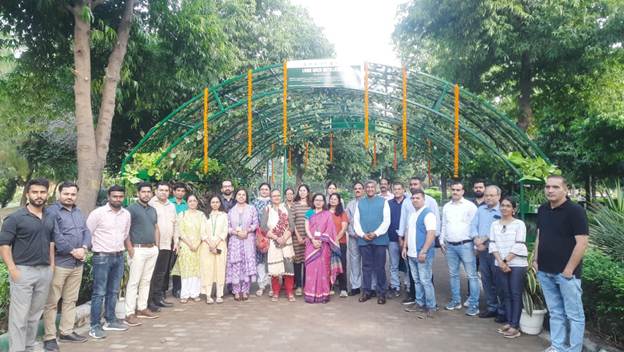
- 12 Oct 2025
In News:
The Ministry of Environment, Forest and Climate Change (MoEFCC) recently inaugurated “Breathable Art” — an innovative living installation at Swarn Jayanti Park, Rohini, Delhi. Conceived under the ‘Breath of Change – Clean Air, Blue Skies’ campaign, the initiative aims to combine artistic expression with ecological functionality to promote awareness on air quality, sustainability, and urban environmental stewardship.
About the Initiative
- Breathable Art is a pioneering “living structure” created from air-purifying plants and eco-friendly materials.
- Sponsored by MoEFCC and supported by the Commission for Air Quality Management (CAQM) and Delhi Development Authority (DDA), it forms part of the Environmental Information, Awareness, Capacity Building and Livelihood Programme (EIACP) under the Environment Education, Awareness, Research and Skill Development (EEARSD) scheme.
- The installation integrates art, science, and community engagement — transforming a public space into an interactive platform for environmental education.
- Visitors can scan QR codes placed around the installation to learn about the plants’ role in air purification and sustainable living practices. This interactive element aims to make environmental learning participatory and accessible.
Features and Ecological Role
The structure uses a mix of air-purifying plant species — such as Areca Palm, Bamboo Palm, Money Plant, Snake Plant, Spider Plant, Parijat, Peace Lily, Arrowhead, Weeping Fig, and Zigzag Plant. These species are recognized for their capacity to absorb harmful pollutants like formaldehyde and benzene, regulate humidity, and enhance oxygen concentration — particularly valuable during Delhi’s winter months when air quality deteriorates sharply.
By embedding these plants into an aesthetically designed structure, Breathable Art offers a passive yet effective solution to urban air pollution. It also enhances local biodiversity and contributes to microclimate regulation within its surroundings.
Community and Educational Dimensions
Beyond its environmental function, Breathable Art serves as:
- An Educational Hub: Hosting students, eco-clubs, and community members for awareness sessions on clean air and sustainable living.
- A Community Catalyst: Encouraging participation of Resident Welfare Associations (RWAs), schools, and volunteers in maintaining and replicating such models across the city.
- A Strategic Urban Intervention: Targeting pollution hotspots to promote green urban aesthetics and inspire behavioral change.
This aligns with India’s broader approach of nature-based solutions for urban environmental management — emphasizing community participation, low-cost interventions, and local ecological resilience.
Significance and Way Forward
- Delhi, one of the world’s most polluted capitals, continues to face critical air quality challenges. Initiatives like Breathable Art highlight how creative, sustainable, and participatory approaches can complement policy-driven measures such as the National Clean Air Programme (NCAP).
- By merging environmental science with public art, the project redefines sustainability as a lived, experiential practice rather than a distant policy goal. It underscores the principle that environmental consciousness begins with individual action and community involvement.
- As urban India grapples with escalating pollution, Breathable Art serves as a replicable model for integrating ecological awareness into everyday spaces — inspiring cleaner, greener, and more mindful cities.
Conclusion:
Breathable Art is not merely an installation but a vision — where art, environment, and community converge to remind citizens that sustainability begins with a single breath. It symbolizes India’s evolving approach to environmental governance — creative, participatory, and rooted in harmony with nature.
India’s Mental Health Crisis: Towards a Unified and Inclusive Response
- 11 Oct 2025
In News:
Every year on October 10, the world observes World Mental Health Day to underscore the growing burden of mental disorders — now affecting over one billion people globally, or 13% of the world’s population. India mirrors this crisis, with a 13.7% lifetime prevalence of mental disorders and rising suicides — 1.71 lakh cases in 2023, including a concerning 65% increase in student suicides over the past decade.
Rising Mental Health Concerns
Globally, anxiety and depression account for two-thirds of all diagnosed mental disorders. Between 2011 and 2021, the number of people with mental disorders rose faster than the world’s population. In India, changing social structures, excessive internet and social media use, academic pressure, and hostile work environments have aggravated psychological distress, especially among the youth. Poor lifestyle habits, reduced family interaction, and economic uncertainty have further deepened the crisis.
Structural Challenges in India’s Mental Healthcare System
India’s mental health system suffers from a triple deficit — of funding, workforce, and governance.
- Budgetary neglect: Mental health receives barely 1.05% of India’s total health expenditure, far below the WHO-recommended 5%.
- Severe workforce shortage: There are only 0.75 psychiatrists and 0.12 psychologists per 1 lakh people, compared to the WHO’s requirement of at least three psychiatrists.
- Treatment gaps: The National Mental Health Survey (2015–16) found 70–92% treatment gaps, meaning most people receive little or no professional care.
- Urban-rural divide: Specialists and rehabilitation facilities are concentrated in cities, while rural India, home to 70% of the population, remains severely underserved.
- Poor infrastructure and stigma: Many psychiatric institutions are plagued by neglect, while deep-rooted social stigma still equates mental illness with personal weakness.
Policy Framework and Initiatives
India has made several progressive policy moves:
- The Mental Healthcare Act, 2017decriminalised suicide attempts, guaranteed the right to mental healthcare, and introduced advance directives allowing patients to choose their treatment.
- The Rights of Persons with Disabilities Act, 2017recognises mental illness as a disability, expanding legal protections.
- In SukdebSaha vs. State of Andhra Pradesh, the Supreme Court affirmed mental health as part of the Right to Life under Article 21, legally obligating the state to ensure quality, accessible care.
- The District Mental Health Programme (DMHP) now operates in 767 districts, providing counselling, suicide prevention, and outreach services.
- The National Tele Mental Health Programme (Tele MANAS), launched in 2022, has enabled over 20 lakh tele-counselling sessions, improving access in underserved areas.
- Initiatives like Manodarpan aim to promote psychological well-being among over 11 crore students.
Learning from Global Models
Countries like Australia, Canada, and the UK allocate 8–10% of their health budgets to mental health and employ mid-level mental health providers who deliver nearly half of all counselling services. These nations also ensure near-universal insurance coverage and maintain real-time mental health surveillance — areas where India still lags.
Way Forward
A unified and decentralised mental health strategy must focus on:
- Raising mental health spending to at least 5% of total health expenditure.
- Expanding and training mid-level providers to bridge the rural-urban gap.
- Fully integrating mental health into primary healthcare and insurance systems.
- Updating diagnostic and policy frameworks in line with WHO’s ICD-11.
- Establishing district-level monitoring and accountability systems.
- Scaling anti-stigma campaigns across schools, workplaces, and communities.
- Ensuring inter-ministerial coordination among health, education, social justice, and labour departments for a cohesive national response.
Conclusion
India’s mental health challenge is not merely a medical issue but a socio-economic and governance imperative. Bridging systemic gaps in funding, workforce, and awareness—while fostering empathy and inclusion—can transform India’s mental health landscape, aligning it with global best practices and the vision of holistic well-being under Article 21 of the Constitution.
Alternative Dispute Resolution (ADR)

- 10 Oct 2025
In News:
India’s judiciary faces an unprecedented crisis of pendency and delay, with over 4.57 crore cases pending across various courts, according to the National Judicial Data Grid (NJDG). Of these, the Supreme Court has about 81,768 cases, and High Courts collectively hold around 62.9 lakh cases. The situation underscores an urgent need to adopt efficient and accessible mechanisms like Alternative Dispute Resolution (ADR) to ensure timely and inclusive justice.
Understanding ADR
Alternative Dispute Resolution (ADR) refers to a set of methods that allow parties to settle disputes outside traditional court systems. It includes:
- Arbitration: A binding process where a neutral arbitrator delivers a decision.
- Conciliation: A non-binding process facilitated by a conciliator to promote settlement.
- Mediation: A voluntary and confidential dialogue process led by a neutral mediator.
- Judicial Settlement / Lok Adalat: Court-referred or community-level settlement platforms.
ADR processes are based on consensus, flexibility, and confidentiality, allowing parties to preserve relationships while saving time and resources.
Why ADR Is Crucial for India
The India Justice Report 2025 highlights critical inefficiencies within India’s justice system — including 33% vacancy in High Courts and 21% in District Courts. Judges in states such as Uttar Pradesh, Himachal Pradesh, and Kerala handle workloads exceeding 4,000 cases each. Prolonged pendency not only delays justice but also undermines trust in legal institutions.
ADR addresses these challenges by offering:
- Speed and Efficiency: Arbitration and mediation significantly reduce case duration compared to conventional litigation.
- Cost-Effectiveness: Reduced procedural formalities make justice affordable and accessible.
- Ease of Doing Business: ADR, especially in commercial disputes, enhances investor confidence by ensuring timely contract enforcement.
- Social Inclusion: Mediation and Lok Adalats provide participatory platforms, particularly beneficial for rural and marginalized communities.
Legal and Constitutional Framework
The foundation of ADR in India rests on multiple legal provisions:
- Article 39A of the Constitution mandates equal access to justice and free legal aid.
- Section 89 of the Code of Civil Procedure (1908) legally recognizes ADR processes such as arbitration, conciliation, and mediation.
- The Arbitration and Conciliation Act, 1996 (amended in 2021) provides the institutional framework, stipulating a 180-day resolution period and creating the Indian Arbitration Council.
- The Mediation Act, 2023 introduces mandatory pre-litigation mediation for civil and commercial disputes, encouraging resolution before approaching courts.
Additionally, Lok Adalats, functioning under the Legal Services Authorities Act, 1987, operationalize Article 39A’s spirit. They include Permanent Lok Adalats, National Lok Adalats, and e-Lok Adalats, offering binding decisions without appeal, thus ensuring swift justice at the grassroots level.
Global and Cultural Resonance
ADR aligns with international standards like the UNCITRAL Model Law, making it essential for cross-border commercial arbitration and foreign investment. At the same time, it resonates with India’s civilisational ethos of collective consensus, reflected in the traditional “Panch Parmeshwar” doctrine — a principle recently highlighted by the Law Minister as a model for community-based dispute resolution.
Conclusion
In an overburdened judicial ecosystem, Alternative Dispute Resolution represents a pragmatic and human-centered reform. Strengthening ADR through legal awareness, institutional support, and public participation can transform India’s justice system into one that is efficient, inclusive, and globally credible. By embracing ADR, India not only advances its constitutional mandate of “speedy justice for all” but also revives its age-old tradition of resolving disputes through dialogue and consensus.
Sharp Decline in Child Marriages in India

- 09 Oct 2025
In News:
A recent survey by Just Rights for Children (JRC), a coalition of over 250 child protection NGOs, has reported a significant decline in child marriages across India. The trend underscores that legal enforcement, community engagement, and multi-sectoral collaboration can collectively transform entrenched social practices that violate children’s rights.
Significance of the Decline
- Human Rights Perspective: Child marriage undermines the fundamental rights of children—particularly girls—to education, health, and personal autonomy. Its reduction reflects progress toward SDG-5 (Gender Equality) and India’s commitments under the UN Convention on the Rights of the Child (UNCRC).
- Health and Demographic Gains: Early marriages often precipitate early pregnancies, increasing risks of maternal mortality, low birth weight, and malnutrition. Delaying marriage improves reproductive health and supports demographic stability by spacing births.
- Educational and Economic Empowerment: Girls who remain in school gain greater social mobility and earning potential. Extended education creates a multiplier effect, reducing inter-generational poverty and enhancing overall human capital.
- Social Norms Transformation: The steep decline challenges the perception that child marriage is inevitable, showing that communities respond to visible enforcement and positive examples of girls pursuing education.
Key Survey Findings
- Assam recorded the highest decline (84%), followed by Maharashtra and Bihar (70% each), Rajasthan (66%), and Karnataka (55%).
- While three children were married every minute during 2019–21, by 2025, only three cases per day were reported.
- Awareness of the Bal Vivah Mukt Bharat campaign reached 99% of respondents.
- In 31% of surveyed villages, all girls aged 6–18 attended school, although Bihar lagged behind.
- Poverty (91%) and safety concerns (44%) remain major drivers of child marriage.
Drivers of the Decline
- Legal Deterrence: Enforcement under the Prohibition of Child Marriage Act, 2006—FIRs and arrests—proved highly effective. Assam’s proactive approach set a national benchmark.
- Awareness Campaigns: Nationwide outreach through schools, media, and Panchayats via Bal Vivah Mukt Bharat fostered community ownership over child rights.
- Community-Based Mechanisms: Karnataka employed helplines and Child Welfare Committees (CWCs), while empowering Panchayat Development Officers to register marriages, preventing around 2,000 child marriages in 2021.
- Multi-Sectoral Collaboration: Integration of legal, social, and economic interventions through state governments, police, education departments, and civil society reinforced enforcement and awareness.
Remaining Challenges
- Under-reporting and hidden marriages, especially in rural and tribal regions.
- Entrenched social norms linked to caste, honour, and family prestige.
- Economic vulnerability, which still drives early marriages in poor households.
- Institutional capacity gaps, including inadequate training and resources for frontline workers.
- Need for robust data to ensure reported progress reflects reality.
Policy Recommendations
- Mandatory Marriage Registration linked with Aadhaar and education databases.
- Targeted Social Protection, expanding schemes like Kanyashree and conditional cash transfers to encourage education and delayed marriage.
- Education and Safety Measures, including improved school infrastructure, transport, and security for girls.
- Grassroots Empowerment, strengthening Panchayats, CWCs, and helplines for early detection.
- Normative Change, involving mass communication, role models, and religious/community leaders.
- Monitoring and Evaluation, through third-party audits, longitudinal surveys, and state dashboards.
Conclusion
India’s decline in child marriages is a landmark achievement in rights-based social reform. The country must now aim to reduce prevalence below 5% by 2030, aligning with the UN Sustainable Development Goals, thereby ensuring that every child’s future is determined by choice, education, and opportunity, rather than compulsion.
Assam-Nagaland Border Dispute

- 08 Oct 2025
In News:
Tensions resurfaced along the Assam–Nagaland border after armed miscreants, allegedly from Nagaland, set fire to nearly 100 houses in a minority-dominated village within the disputed B Sector of Assam’s Golaghat district.
Background of the Dispute
- The Assam–Nagaland border dispute concerns overlapping territorial claims, particularly over forested tracts in Assam’s Golaghat, Jorhat, and Sivasagar districts, collectively known as the Disputed Area Belt (DAB).
- Since 1979, the Central Reserve Police Force (CRPF) has been deployed as a neutral force to maintain peace in these contested zones.
Historical Evolution
- Colonial Period (1826–1925):Following the Treaty of Yandabo (1826), the British annexed Assam and later established the Naga Hills District (1866). Subsequent boundary notifications redefined territories several times—often without consulting local Naga communities.
- Post-Independence Developments (1947–1963):The Nagas declared independence in 1947. Later, the Naga Hills–Tuensang Area Act (1957) and the State of Nagaland Act (1962) formalized Nagaland’s creation but did not define its boundary clearly with Assam, leaving scope for future disputes.
Commissions and Efforts at Resolution
Several commissions and agreements have attempted to resolve the dispute but failed to achieve a lasting solution:
- Sundaram Commission (1972): Led to four interim agreements maintaining the status quo.
- Shastri Commission (1985) and J.K. Pillai Commission (1997): Explored settlement options but faced rejection by one or both states.
- Variava and Chatterjee Commissions (2006): Submitted findings on boundary delineation, but implementation remained stalled.
Disputed Area Belt (DAB)
- The DAB covers forest land along the 512.1 km-long Assam–Nagaland boundary, primarily spanning Golaghat, Jorhat, Sivasagar, and KarbiAnglong districts of Assam.
- These forests were historically used by Naga tribes but fall within Assam’s constitutional limits.
Core of the Territorial Claims
- Assam’s Position:Assam upholds the constitutional boundary established when Nagaland was created in 1963, asserting that this demarcation is legally final.
- Nagaland’s Position:Nagaland bases its claim on historical and traditional Naga homelands, citing the 16-Point Agreement of 1960 and pre-colonial territorial arrangements. It seeks “restoration” of areas allegedly separated during British rule.
- Extent of Dispute:Assam accuses Nagaland of encroaching on over 60,000 hectares of land within the DAB.
Ethics at the Heart of Global Climate Action
- 07 Oct 2025
In News:
As the world approaches COP30 in Brazil (2025), the role of ethics in climate governance has been revived through the launch of the Global Ethical Stocktake. This initiative aims to place justice, equity, responsibility, and intergenerational fairness at the core of global climate action, complementing the scientific urgency highlighted by rising emissions and warming temperatures.
Ethical Dimensions of Climate Action:
- Justice and Equity:
- The principle of common but differentiated responsibilities under the UNFCCC reflects fairness—developed nations bear historical responsibility, while developing nations require space for sustainable growth.
- The Paris Agreement’s “leave no one behind” principle embodies distributive justice.
- Intergenerational Responsibility:
- Present decisions affect the survival prospects of future generations. Ethical stewardship, not exploitation, is essential.
- In 2025, the International Court of Justice reaffirmed intergenerational equity as central to climate treaties.
- Human Rights Linkage:
- Access to food, water, housing, and a healthy environment is inseparable from the right to life (Article 21, Indian Constitution).
- The Inter-American Court (2024) declared the right to a safe climate a fundamental human right.
- Integrity and Credibility:
- The gap between climate promises and delivery undermines trust. Ethical governance requires accountability, transparency, and scientific rigor in Nationally Determined Contributions (NDCs).
- Corporate greenwashing erodes credibility, emphasizing the need for ethical corporate responsibility.
- Solidarity with the Vulnerable:
- Marginalized groups, Indigenous peoples, and communities in the Global South face disproportionate risks. Ethical climate action ensures inclusion and empathy in adaptation strategies.
- Community-based initiatives, such as the Himachal Pradesh snow leopard survey, illustrate ethics of inclusion in environmental stewardship.
Role of Ethics in Governance:
- Guiding Negotiators: Ethics reminds negotiators of moral responsibility, where delays equate to human suffering and ecosystem loss.
- Embedding Frameworks: Initiatives like the Global Ethical Stocktake institutionalize ethics alongside scientific assessments.
- Judicial Oversight: Courts link morality with law, compelling states to respect climate and human rights obligations.
- Corporate Responsibility: Businesses must adopt ethical approaches to avoid tokenistic climate pledges.
Ethics in the Indian Context:
- Constitutional Mandates:
- Article 48A – Duty of the State to protect the environment.
- Article 51A(g) – Duty of citizens to protect natural resources.
- Judicial Precedents: Vellore Citizens’ Forum vs Union of India (1996) upheld the precautionary principle and polluter pays principle.
- Gandhian Philosophy: Trusteeship aligns with sustainable consumption and responsibility toward nature.
Challenges:
- National interest vs. global good delays climate finance and technology transfer.
- Political polarization and denialism hinder consensus despite rising urgency.
- Greenwashing and weak enforcement erode accountability.
- Adaptation finance remains underfunded, leaving vulnerable populations exposed.
Way Forward:
- Institutionalize the Global Ethical Stocktake to align climate action with justice and equity.
- Implement just transition policies protecting livelihoods while shifting from fossil fuels.
- Strengthen ethical climate jurisprudence to ensure rights-based accountability.
- Promote ethical leadership and integrate climate ethics into education and policymaking.
Conclusion:
Climate change is as much a moral challenge as a scientific one. Ethics—anchored in justice, responsibility, solidarity, and intergenerational equity—must guide global action. Embedding ethics into negotiations, law, community initiatives, and corporate practices is essential to restore credibility, build trust, and ensure a liveable planet for present and future generations.
Heritage Management and Conservation in India

- 06 Oct 2025
In News:
- India’s rich cultural and architectural legacy, reflected in thousands of ancient monuments and archaeological sites, has long been under the stewardship of the Archaeological Survey of India (ASI).
- Established in 1861, the ASI functions under the Ministry of Culture and enforces the Ancient Monuments and Archaeological Sites and Remains Act, 1958, and the Antiquities and Art Treasures Act, 1972.
- However, with over 3,700 protected monuments under its care, the ASI’s capacity constraints have often resulted in delays and maintenance backlogs.
- Recognizing this challenge, the government has initiated a landmark policy shift to introduce public-private partnerships (PPP) in heritage conservation — marking a major reform in India’s cultural governance.
The Policy Shift
- For the first time, the core conservation of protected monuments will no longer be ASI’s exclusive domain. Under the new model, private players, corporates, and public sector undertakings can directly fund and implement conservation projects under ASI’s supervision. This move seeks to expand capacity, accelerate timelines, and leverage private expertise, while retaining strict professional and regulatory oversight.
- All projects will be monitored by the ASI and must comply with the National Policy for Conservation of Ancient Monuments, Archaeological Sites and Remains (2014). The initiative aims to balance modernization and preservation by fostering collaboration between government, industry, and civil society.
Institutional Framework and Implementation
- The reforms will operate through the National Culture Fund (NCF), established in 1996 with an initial government corpus of ?20 crore.
-
- The NCF enables donors to contribute directly to heritage projects and offers 100% CSR tax exemptions, incentivizing private participation.
-
- To ensure professional standards, the Ministry of Culture will empanel conservation architects of national repute, who will guide donors in planning and executing projects. The Detailed Project Reports (DPRs) will require ASI approval before implementation.
- Private donors, guided by these architects, can hire external implementing agencies experienced in restoring structures over 100 years old. Initially, a list of 250 monuments requiring urgent conservation will be released for donor selection.
Track Record of the National Culture Fund
Since its inception, the NCF has mobilized around ?140 crore in corporate and public donations, supporting over 100 conservation projects. Notable examples include:
- Bhuleshwar Temple (Pune),
- British Residency (Hyderabad),
- Group of Monuments at Mandu,
- Purana Qila and Red Fort site museums (New Delhi),
- Ongoing work at Vikramshila (Bihar), Deobaloda (Chhattisgarh), and Singorgarh Fort (Madhya Pradesh).
Significance and Safeguards
- The PPP model represents a shift from state monopoly to collaborative stewardship, ensuring accountability, transparency, and efficiency.
- The ASI retains its supervisory authority, maintaining consistency with India’s constitutional framework, where heritage conservation falls under both Union and State jurisdictions, as outlined in the Seventh Schedule and Article 253.
- Qualified conservation architects, empanelled through due diligence, will ensure technical integrity, while all financial contributions must pass through the NCF to prevent misuse. The government views this as a cautious, phased reform, initially assigning private players a supplementary role to test the model’s viability.
Comparison with Past Initiatives
Unlike the earlier ‘Adopt a Heritage’ scheme, which allowed corporates to develop tourist amenities such as cafes and restrooms as “monument mitras,” the current initiative extends to core conservation work. This marks a decisive evolution from heritage promotion to heritage preservation.
Conclusion
India’s new heritage management framework reflects a pragmatic blend of Aatmanirbhar Bharat, cultural preservation, and corporate participation. By integrating private sector efficiency with ASI’s institutional expertise, the model promises to make heritage conservation financially sustainable, technologically advanced, and socially participatory — ensuring that India’s timeless legacy endures through collective stewardship.
India’s Deep-Sea Mineral Exploration in the Indian Ocean

- 05 Oct 2025
In News:
India has achieved a major milestone in deep-sea exploration by signing a new 15-year contract with the International Seabed Authority (ISA) for the exclusive exploration of Polymetallic Sulphides (PMS) in a 10,000 sq km area of the Carlsberg Ridge in the Indian Ocean.
With this agreement, India has become the first country in the world to hold two PMS exploration contracts, commanding the largest area allocated globally for such exploration. This advancement marks a blend of scientific progress, strategic foresight, and economic opportunity within India’s broader Blue Economy vision.
Polymetallic Sulphides and Their Significance
Polymetallic Sulphides are mineral-rich deposits found on the ocean floor, primarily near hydrothermal vents along mid-ocean ridges. Formed through interactions between seawater and magma beneath the Earth’s crust, they contain valuable metals such as copper, zinc, lead, gold, silver, and trace rare elements.
For India, these minerals are crucial for high-technology industries, renewable energy systems, and green technologies. Given the country’s limited terrestrial reserves, deep-sea exploration ensures resource security, supports the energy transition, and reduces import dependence on critical minerals.
India’s Deep Ocean Initiatives
India’s engagement with the ISA dates back over three decades. It was among the earliest countries to receive an area for polymetallic nodule exploration, earning the status of a “Pioneer Investor.” The first PMS exploration contract was signed in 2016 for the Central and Southwest Indian Ridges, and the latest agreement in 2025 extends exploration to the Carlsberg Ridge, located near 2°N latitude — significantly closer to India than the earlier sites.
The National Centre for Polar and Ocean Research (NCPOR) in Goa, under the Ministry of Earth Sciences (MoES), will begin exploration operations in 2026, employing geophysical, hydrographic, and near-seabed surveys.
These efforts are supported by the Deep Ocean Mission, launched by the Government of India to develop seabed mining technology, autonomous underwater vehicles (AUVs), and the Matsya submersible under the Samudrayaan Mission. This ecosystem strengthens India’s capacity for scientific research, environmental assessment, and mineral resource utilisation.
The Carlsberg Ridge: A Strategic and Scientific Hub
The Carlsberg Ridge is a part of the mid-ocean ridge system formed by the divergence of the Indian and Somali plates about 40 million years ago. With a spreading rate of 2.4–3.3 cm per year, it features hydrothermal vent systems ideal for PMS deposits. Its proximity to India enhances logistical feasibility and strategic relevance. The region’s exploration will expand understanding of deep-sea geology, marine ecosystems, and plate tectonics, while supporting India’s long-term maritime interests.
Exploration Challenges and Governance
PMS exploration is among the most technically demanding deep-sea missions, occurring at depths of 2,000–5,000 metres in rugged, volcanic terrains. It demands multidisciplinary collaboration across marine geology, geophysics, biology, and ocean engineering, supported by dynamic-positioning vessels, AUVs, and ROVs.
The ISA, functioning under the United Nations Convention on the Law of the Sea (UNCLOS), regulates seabed exploration beyond national jurisdictions. Applications must meet rigorous standards of environmental protection, financial capability, and scientific planning before approval.
Future Prospects
Beyond PMS, India has applied for exploration rights over cobalt-rich ferromanganese crusts on the Afanasy-Nikitin Seamount in the Central Indian Ocean, aligning with its Blue Economy and resource security goals. Hosting the 8th ISA Annual Contractors’ Meeting in Goa underscores India’s growing leadership in global seabed research governance.
Conclusion
India’s twin PMS contracts with the ISA mark a historic milestone in ocean science, resource diplomacy, and sustainable technology development. By combining strategic exploration, indigenous innovation, and environmental stewardship, India is positioning itself at the forefront of responsible deep-sea resource management — a critical pillar of its vision for a self-reliant and resilient Blue Economy.
India’s E-Waste Recycling Challenges and Opportunities
- 04 Oct 2025
In News:
Electronic waste, or e-waste, has emerged as one of the fastest-growing waste streams globally, driven by rapid technological obsolescence, consumerism, and the digital transformation of economies. E-waste refers to discarded electronic devices—such as mobile phones, laptops, televisions, and refrigerators—that contain both valuable materials like gold, copper, and lithium, and hazardous substances like lead, mercury, and cadmium. The dual nature of e-waste—an economic resource and an environmental hazard—makes its management a critical policy challenge for India.
The Scale of the Problem
According to the Global E-Waste Monitor 2020, India is the world’s third-largest generator of e-waste after China and the USA. The country produced around 4.17 million metric tonnes of e-waste in 2022, yet only one-third was processed through authorized recyclers. With India’s electronics industry projected to grow at a CAGR of 16.6%—from USD 215 billion in FY19 to USD 540 billion by FY25—the volume of e-waste is expected to surge further. This growth is compounded by the increasing number of broadband and smartphone users, currently exceeding 93.9 crore, reflecting expanding consumption and shorter product lifecycles.
Environmental and Health Implications
Improper e-waste disposal leads to severe ecological and health impacts. Open burning and acid leaching—common in informal recycling—release toxic fumes and contaminate soil and groundwater. Heavy metals such as lead and cadmium cause neurological and renal damage, while persistent organic pollutants affect ecosystems and biodiversity. The World Health Organization has warned that children and informal workers face disproportionate exposure risks, underscoring the urgent need for safe handling and regulation.
Policy and Institutional Framework
India’s e-waste management is governed by the E-Waste (Management) Rules, 2022, notified by the Ministry of Environment, Forest and Climate Change (MoEFCC), and effective from April 2023. These rules emphasize Extended Producer Responsibility (EPR), mandating manufacturers and importers to collect and recycle end-of-life products. The Central Pollution Control Board (CPCB) has initiated audits of recyclers to curb “paper trading” and ensure genuine recycling practices. Moreover, a ?1,500 crore Mineral Recycling Scheme was launched in 2023 to recover critical metals like copper, aluminium, cobalt, and lithium, reducing import dependence amid geopolitical supply risks.
Gaps and Challenges
Despite robust policy intent, significant implementation challenges persist. A 2023 Indian Cellular and Electronics Association report highlighted the dominance of the informal sector, which manages nearly 90% of India’s e-waste through unsafe methods. Lack of material traceability, inadequate inventorying by State Pollution Control Boards, and weak enforcement mechanisms further hamper progress. Experts also note the absence of uniform data and poor public awareness about responsible disposal.
Recent Initiatives and Future Potential
Government efforts, such as the Prime Minister’s Science, Technology, and Innovation Advisory Council (PM-STIAC) initiatives, promote indigenous R&D, technology transfer, and a national e-waste catalog through the I-STEM portal. Institutions like CMET, BARC, and NML are collaborating with industries to deploy eco-friendly recycling technologies. Private players such as Attero have begun aggregating informal setups into formal “mandi-style” recycling networks, aiming to recover metals sustainably. With appropriate regulatory and market support, India could meet up to 70% of its rare earth metal needs domestically within 18 months.
Conclusion
E-waste management lies at the intersection of environmental protection, resource efficiency, and industrial policy. Strengthening the EPR mechanism, integrating informal recyclers, improving traceability, and incentivizing circular design are essential for sustainable growth. Effective e-waste management supports India’s commitments under SDG 12 (Responsible Consumption and Production) and SDG 13 (Climate Action), and can transform waste into a strategic resource, reinforcing India’s journey toward a green and self-reliant economy.
Corporate Average Fuel Efficiency (CAFE) 3 Norms
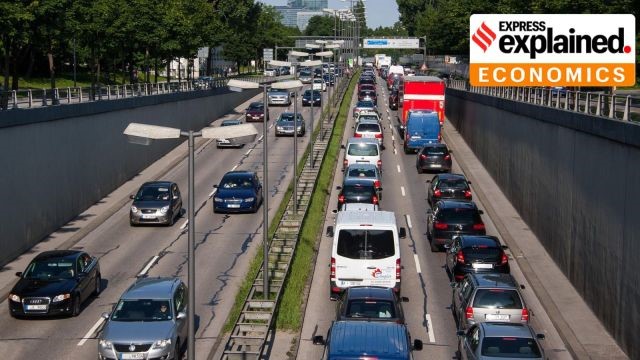
- 03 Oct 2025
In News:
- India has proposed the Corporate Average Fuel Efficiency (CAFE) 3 norms, drafted by the Bureau of Energy Efficiency (BEE), aiming to tighten fuel efficiency standards, reduce vehicular emissions, and promote electric and alternative fuel vehicles.
- First introduced in 2017, CAFE norms regulate fuel consumption and CO? emissions for passenger vehicles weighing up to 3,500 kg, including petrol, diesel, CNG, LPG, hybrid, and electric vehicles.
- The earlier iteration, CAFE 2 (2022-23), capped fuel consumption at 4.78 litres/100 km and CO? emissions at 113 g/km, with penalties for non-compliance.
Need for CAFE 3
Current Indian norms inadvertently favourheavier vehicles like SUVs while imposing stringent targets on smaller cars, unlike international practices in the USA, EU, China, and Japan, where light vehicles enjoy relaxed emission standards. CAFE 3 seeks to align India with global best practices, revive the small car segment, and incentivisegreen mobility, particularly electric vehicles (EVs) and hybrids.
Key Features of CAFE 3 Norms
1. Applicability
- Targets M1 category passenger vehicles (seating up to nine people, maximum weight 3,500 kg).
- Non-compliance will attract penalties under the Energy Conservation Act, 2001.
2. Efficiency Targets
- Efficiency formula: [0.002 × (W – 1170) + c], measured in petrol-equivalent litres/100 km, where W is fleet weight, 1,170 kg is a fixed constant, 0.002 is a multiplier, and ‘c’ decreases yearly from 3.7264 (FY28) to 3.0139 (FY32).
- Lighter vehicles benefit from easier compliance, motivating manufacturers to focus on small cars.
- Additional relaxation: 3.0 g CO?/km (capped at 9 g/km) for compact cars (<909 kg, ≤1200 cc engine, ≤4,000 mm length).
3. Incentives for EVs and Alternative Fuels
- Super credits: Each EV sold counts three times toward fleet compliance; plug-in hybrids 2.5×, strong hybrids 2×, flex-fuel ethanol vehicles 1.5×.
- Carbon Neutrality Factor (CNF): Offers relaxation based on fuel type (e.g., E20–E30 petrol vehicles 8% CNF; strong hybrids 22.3%).
4. Emissions Pooling
- Up to three manufacturers can form a pool, treated as a single entity for compliance.
- Pool managers are legally responsible for penalties, allowing strategic partnerships, cost-sharing, and smoother adherence to targets.
Policy Complementarities
- GST reforms (GST 2.0) reduced taxes on small cars from 28% to 18%, complementing the relaxation measures under CAFE 3.
- By incentivisingEVs, hybrids, and small vehicles, the norms aim to reduce oil import dependency and advance India’s climate commitments under the Paris Agreement.
Challenges
- Industry adaptation: Transitioning fleets to comply with stricter norms while managing costs.
- Consumer acceptance: Affordability and infrastructure readiness for EVs and hybrids.
- Infrastructure readiness: Charging and fuel infrastructure for alternative vehicles needs significant expansion.
Conclusion
CAFE 3 represents a transformative step in India’s vehicular emission regulation, combining fuel efficiency improvements, emission reductions, and green mobility incentives. By aligning with global practices, reviving the small car segment, and encouraging electric and hybrid vehicles, the norms have the potential to accelerate sustainable transportation while addressing environmental and energy security goals. Successful implementation will require coordinated action between manufacturers, policymakers, and consumers to build a cleaner, efficient, and resilient automotive sector in India.
Reimagining Green Economy through Landscapes
- 02 Oct 2025
In News:
India stands at a critical juncture where the pursuit of economic growth must align with environmental sustainability. The transition to a green economy offers an opportunity to reshape the country’s development paradigm—one that integrates ecological balance, inclusive livelihoods, and technological innovation within a landscape-driven framework.
India’s Green Economy: Growth and Scope
India’s bioeconomy has expanded remarkably from $10 billion in 2014 to $165.7 billion in 2024, growing sixteenfold and accounting for 4.25% of the national GDP. This growth, driven by over 10,000 bio-based start-ups, spans biofuels, bioplastics, pharmaceuticals, and bioinformatics. The industrial bioeconomy contributes nearly half the sectoral share, while India’s achievements—such as 20% ethanol blending in petrol and becoming the third-largest pharmaceutical producer by volume—reflect the scale of progress.
A green economy, however, extends beyond bio-based industries. It encompasses low-carbon growth, circular resource use, ecosystem restoration, and inclusive employment. By 2030, it is estimated to create 35 million green jobs, strengthening India’s resilience against climate shocks and enhancing energy security under Aatmanirbhar Bharat.
Challenges in the Green Transition
Despite this momentum, India’s green growth exhibits deep regional and socio-economic disparities. Urban centers like Maharashtra, Karnataka, and Gujarat dominate green investments, while the North-Eastern and tribal states contribute less than 6% despite abundant natural resources. This spatial imbalance mirrors unequal access to clean energy, irrigation, and digital infrastructure.
Simultaneously, energy transition dilemmas persist. While renewables are expanding, fossil fuel subsidies—still around 40%—undermine emission reduction efforts. In agriculture, solar pump deployment risks groundwater depletion, highlighting the complexity of balancing environmental and livelihood goals. Hard-to-abate sectors such as steel, cement, and power, which contribute nearly 23% of GHG emissions, face prohibitive costs for green technologies—often four times higher than conventional alternatives.
Social inclusion remains another challenge. Women hold only 11% of rooftop solar jobs, and their share in technical green roles is as low as 1–3%. Similarly, tribal and marginalised communities remain passive beneficiaries rather than active stakeholders in climate action.
Reimagining the Green Economy through Landscapes
A landscape-based approach can make India’s green transition more inclusive and ecologically coherent. Landscapes represent interconnected systems of land, water, biodiversity, and human activity. Integrating these systems through participatory planning—from village to national level—can enhance ecosystem services such as air and water regulation, soil fertility, and climate moderation.
Institutionally, leveraging 2.5 lakh Panchayati Raj Institutions (PRIs) and 12 million women-led Self-Help Groups (SHGs) can embed community ownership into green initiatives. Promoting tribal-led bioeconomy models based on non-timber forest produce, agro-waste reuse, and medicinal flora can align conservation with livelihoods.
Technology and fiscal innovation must complement this vision—through green budgeting, public procurement of sustainable products, and expansion of 5G/6G labs for greening digital infrastructure. Decentralised waste management and circular economy practices are vital, especially as urban areas generate 75% of India’s solid waste.
Conclusion
India’s green transformation must evolve from a sectoral to a landscape-driven, community-based model that harmonises economic growth with ecological integrity. Empowering local institutions, mainstreaming gender, and integrating traditional knowledge with modern innovation will be crucial to achieving a just and resilient green future. By 2047, the goal should not merely be higher GDP, but ecological regeneration, social equity, and global climate leadership.
National Security Act (NSA)

- 01 Oct 2025
Context:
The detention of climate activist Sonam Wangchuk under the National Security Act (NSA), 1980, has reignited a long-standing debate on the balance between national security and civil liberties in India. Wangchuk, who has been leading the movement for Ladakh’s statehood and Sixth Schedule protections, was detained following alleged provocative speeches that, according to the administration, triggered violent protests in Leh leading to four deaths and several injuries. His case illustrates the continuing tension between state power and individual freedoms under India’s preventive detention framework.
Understanding Preventive Detention in India
Preventive detention refers to the practice of detaining an individual not for a crime already committed, but to prevent them from acting in a manner considered prejudicial to public order, security, or essential supplies. Unlike punitive detention, which follows conviction through due process, preventive detention is anticipatory in nature—aimed at averting potential threats before they materialise.
The Constitutional sanction for preventive detention is provided under Article 22 (Clauses 3–7), which permits Parliament and State legislatures to enact laws allowing such detention. A person can be held for up to three months without approval from an Advisory Board of judges, and longer if such approval is obtained. However, detainees are denied the right to legal counsel before the Advisory Board, and authorities may withhold information on grounds of public interest—limiting transparency and accountability.
Evolution of Preventive Detention Laws
Preventive detention has deep colonial roots, beginning with wartime laws such as the Defence of India Acts and the Rowlatt Act (1919). Post-Independence, the Preventive Detention Act, 1950, institutionalised this power, followed by the Maintenance of Internal Security Act (MISA), 1971, which gained notoriety during the Emergency (1975–77). Although MISA was repealed in 1978, preventive detention returned with the National Security Act (NSA), 1980, reflecting the persistence of this legal mechanism in India’s security architecture.
Provisions and Safeguards under the NSA
The NSA empowers the Central and State governments, as well as authorisedDistrict Magistrates and Police Commissioners, to detain individuals to prevent actions “prejudicial to India’s defence, foreign relations, national security, public order, or essential supplies.”
- Detention orders operate like arrest warrants, allowing transfer across states and detention up to 12 months.
- Grounds for detention must be communicated within 5 to 15 days, and the detainee can submit a representation to the government.
- An Advisory Board of High Court judges must review the case within three weeks and order release if “no sufficient cause” exists.
However, no legal representation is allowed before the Board, and the government may withhold crucial information—leaving wide discretion in official hands.
Use and Misuse: Judicial and Public Concerns
Over the decades, NSA has been used in cases involving separatists, radical preachers, gangsters, and protesters. Notable instances include the detention of Amritpal Singh (2023), Bhim Army chief Chandrashekhar Azad (2017), and Dr. Kafeel Khan (2020). Courts have repeatedly intervened in cases of misuse, emphasising that the Act cannot be a substitute for ordinary criminal law. The Supreme Court’s 2012 ruling striking down detention for kerosene black-marketing underscored this misuse.
Critics argue that preventive detention contradicts the spirit of fundamental rights under Articles 19, 21, and 22, allowing incarceration without trial and enabling governments to suppress dissent under the guise of maintaining order. Scholars contend that Article 22 itself legitimises preventive detention, reflecting what Erich Fromm described as a “fear of freedom”—a societal tendency to trade liberty for perceived security.
Conclusion
The National Security Act remains one of India’s most powerful yet controversial laws. While it provides governments with a vital tool to prevent threats to national security and public order, its frequent and often arbitrary invocation erodes constitutional guarantees of liberty and due process.
The detention of Sonam Wangchuk serves as a stark reminder that preventive detention laws, though constitutionally sanctioned, sit uneasily within a democratic framework. India’s challenge lies in ensuring that security imperatives do not eclipse fundamental freedoms, reaffirming the Constitution’s promise of liberty, justice, and accountability.
